ISS Utilization: ACES (Atomic Clock Ensemble in Space) / PHARAO
Science
ISS Utilization: ACES (Atomic Clock Ensemble in Space) / PHARAO
ACES is an ESA ultra-stable clock experiment, a time and frequency mission to be flown on the Columbus module of the ISS (International Space Station), in support of fundamental physics tests. The mission objectives are both scientific and technological and is of great interest to two main scientific communities:
• The Time and Frequency (T&F) community; which aims to use ACES as a tool for high precision Time and Frequency metrology
• The Fundamental Physics community; which will benefit from the use of ACES data for accurate tests of general relativity.
The fundamental aspects of ACES deal with the physics of a cold atom clock. For the first time cold atoms will be operated in conditions which are not realizable on Earth in order to perform fundamental physics tests (relativity, possible drift of fundamental constants with time). At the same time, a number of new technologies needed by the science community, will be validated. Furthermore, the science community could take advantage worldwide of the ACES frequency stability by using ground stations to download the ACES time reference. These aspects will become increasingly important with future developments of navigation and positioning systems, new "matter-wave" inertial sensors and fundamental physics tests in solar orbit. 1) 2) 3) 4)
The ACES development was initiated in the 1990s. However, the decision to complete the development of the project has been achieved only at the ESA council at Ministerial Level of November 2008.
Test of New Generation of Space Clocks
The basic question is: Do fundamental physical constants vary with time? A possible solution: Time variations of fundamental constants can be measured by comparing clocks based on different transitions or different atomic species. The microgravity environment of space is most suitable for experiment. 5) 6) 7) 8) 9)
A new generation of clocks, reaching frequency instability and inaccuracy of a few parts in 1016, will be validated by ACES. The cesium clock PHARAO will combine laser cooling techniques and microgravity conditions to significantly increase the interaction time and consequently reduce the linewidth of the clock transition. Improved stability and better control of systematic effects will be demonstrated in the space environment.
ACES Scientific Objectives
The overall ACES mission and the associated architecture definition is based on a set of scientific objectives. They can be summarized in the following parts (Ref. 12):
1) Primary objectives:
• High Performance Space Clocks and Time and Frequency link. To demonstrate the high performance of a new generation of atomic clocks in the space environment and the ability to achieve high stability on space-to-ground time and frequency transfer.
• Comparisons of Ground Clocks via the ACES Microwave Link. To demonstrate the capability of comparing ground clocks at high resolution on a worldwide basis using a link in the microwave domain.
2) Fundamental physics experiments:
• Gravitational Red-shift. To measure with an improved accuracy the Einstein's gravitational red-shift.
• Drift of Fine Structure Constant. To measure time variations of the fine structure constant α at an increased level of accuracy.
• Anisotropy of Light. To test the validity of special relativity by detecting a possible anisotropy of the light velocity with an improved accuracy.
3) Secondary objectives:
• Space Hydrogen Maser long–term stability. To characterize the long–term stability of a space active Hydrogen maser.
• Ground Clock Synchronization. To demonstrate the feasibility of synchronization of ground clocks with a low inaccuracy.
• Contribution to the International Atomic Time Scale. To incorporate the ACES timescale into the TAI improving its accuracy.
• Distribution of the Ultra-stable ACES Time Scale. To demonstrate the capability of transmitting to ground users an ultra–stable time scale with a good time accuracy.
4) Scientific Applications:
• Relativistic Geodesy. To demonstrate the feasibility of mapping the geoid with a good space and time accuracy.
• European Laser Timing
- Time Transfer. To perform time transfer via a single and dual laser link.
- Laser Ranging. To use SLRs (Satellite Laser Rangings) to perform ISS ranging.
• Clock Comparisons via the GNSS Network. To support applications in the different areas of time and frequency transfer via the GNSS network.
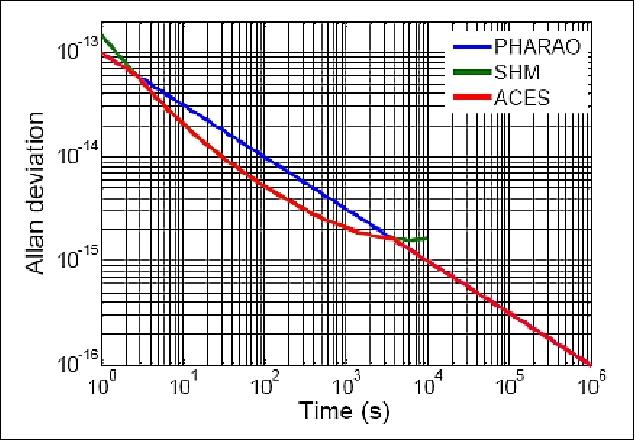
The reliability offered by active H-masers will be made available for space applications by SHM (Space Hydrogen Maser). SHM will demonstrate a fractional frequency instability of 1.5 x 10-15 after only 10000 seconds of integration time. Two servo-loops will lock together the clock signals of PHARAO and SHM generating an on-board time scale combining the short-term stability of the H-maser with the long-term stability and accuracy of the cesium clock.
Stable and accurate time and frequency transfer via a dedicated Microwave Link: The accurate and stable ACES clock signal will be distributed by a dedicated MWL (Microwave Link). Frequency transfer with time deviation better than 0.3 ps (picoseconds) at 300 seconds, 7 ps at 1 day, and 23 ps at 10 days of integration time will be demonstrated. These performances, surpassing existing techniques, namely TWSTFT (Two-Way Satellite Time and Frequency Transfer) and GPS, by one to two orders of magnitude, will enable common view and non-common view comparisons of ground clocks with 10-17 frequency resolution after few days of integration time.

Applications
ACES will also demonstrate a new technique, called "relativistic geodesy", to map the Earth gravitational potential. This technique uses a precision measurement of the Einstein's gravitational red-shift between two clocks to determine the corresponding difference in the local gravitational potentials. The possibility of performing comparisons of ground clocks at the 10-17 frequency uncertainty level will allow ACES to resolve geopotential differences at 10 cm.
A dedicated GNSS receiver on-board the ACES payload will ensure orbit determination, important for comparing clocks and performing fundamental physics tests. In addition, the GNSS subsystem will be connected to the ACES clock signal, opening the possibility to use the GNSS network for clock comparisons or remote sensing applications (GNSS radio-occultation and reflectometry).
In addition to the ACES MWL, the ELT (European Laser Timing) link will allow clock comparisons, time transfer, and ranging experiments in the optical domain. The combination of ELT and MWL will provide a bench to test two different time transfer and ranging techniques, also opening the door to studies of atmospheric propagation delays.
Some Background
In 1967, the "second" – as the base unit for time in the SI – was newly defined as the duration of 9,192,631,770 periods of the radiation corresponding to the transition between the two hyperfine levels of the ground state of the Cesium–133 atom ( 133Cs). This new definition improved the accuracy to extremely high values, if compared to the previous standard ephemeris second, based on the Earth's orbit around the Sun. [Note: Previously, the SI second was defined as 1/31355925.9747 of the time taken for the Earth to orbit around the Sun at the epoch of 1900] This new extremely reproducible definition made possible, for the second, to become a privileged unit among others and gave an impressive momentum to the usage of atomic clocks and and related research (Ref. 12).
Atomic clocks based on Cesium atoms are commonly called primary frequency standards because they are used for the operative definition of the SI Second. At present the most stable and accurate clocks are represented by atomic fountains based on laser cooled atoms.
ACES, an ESA mission in fundamental physics, is based on a new generation of clocks operated in the microgravity environment of the ISS. One of the atomic clocks of ACES, namely PHARAO – a primary frequency standard developed by CNES and based on laser cooled cesium atoms – extends the functioning principle of a ground atomic fountain to microgravity conditions, taking advantage of weightlessness to have a more versatile and accurate clock.
A second atomic clock, SHM (Space Hydrogen Maser), an active hydrogen maser for space applications is compared and locked, one to the other, with PHARAO by means of the FDCP (Frequency Comparison and Distribution Package), in order to generate an O/B (On-Board) time scale that combines the short-term stability of SHM and the long-term stability and accuracy of PHARAO.
This O/B time and frequency reference is then distributed via a dual-frequency MWL (Microwave Link) and a laser link, ELT (European Laser Timing), to ground sites situated all over the world.
The unprecedented accuracy that ACES is expected to reach in microgravity conditions (time drift of 1 x 10-16 s/s), corresponding to a time error of about 1 s over 300 million years, allows to open the way to a lot of improvements on the observation of physical phenomena. As an example, the prediction of Einstein's general relativity theory is that time linked to gravity, such that, for instance, it passes faster at the top of Mount Everest than at sea level. These effects have been proved in experiments on Earth. ACES will make more precise measurements as it flies 400 km high on the ISS. The accurate ACES time reference and the distribution via the microwave and laser links will allow ACES to perform tests of Einstein's theory of general relativity, including an accurate measurement of the gravitational red-shift, a search for time variations of fundamental constants and tests of the Standard Model Extension. ACES also develops applications in different areas of research, including geodesy and Earth observation.
Clocks, Gravity, and the Limits of Relativity
May 2019: The International Space Station will host the most precise clocks ever to leave Earth. Accurate to a second in 300 million years the clocks will push the measurement of time to test the limits of the theory of relativity and our understanding of gravity. 10)
Albert Einstein's general theory of relativity predicted that gravity and speed influences time, the faster you travel the more time slows down, but also the more gravity pulling on you the more time slows down.
On 29 May 1919, Einstein's theory was first put to the test when Arthur Eddington observed light "bending" around the Sun during a solar eclipse (Figure 3). Forty years later, the Pound-Rebka experiment first measured the redshift effect induced by gravity in a laboratory – but a century later scientists are still searching for the limits of the theory.
"The theory of relativity describes our Universe on the large scale, but on the border with the infinitesimally small scale the theory does not jibe and it remains inconsistent with quantum mechanics," explains Luigi Cacciapuoti, ESA's Atomic Clock Ensemble in Space (ACES) project scientist. "Today's attempts at unifying general relativity and quantum mechanics predict violations of the Einstein's equivalence principle."
Einstein's principle details how gravity interferes with time and space. One of its most interesting manifestations is time dilation due to gravity. This effect has been proven by comparing clocks at different altitudes such as on mountains, in valleys and in space. Clocks at higher altitude show time passes faster with respect to a clock on the Earth surface as there is less gravity from Earth the farther you are from our planet.
Flying at 400 km altitude on the Space Station, the Atomic Clock Ensemble in Space will make more precise measurements than ever before.
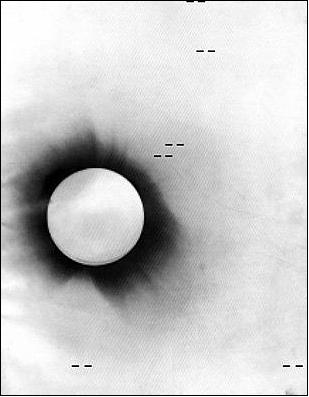
Internet of Clocks
ACES will create an "internet of clocks", connecting the most accurate atomic timepieces the world over and compare their timekeeping with the ones on humankind's weightless laboratory as it flies overhead.
Comparing time down to a stability of hundreds femtoseconds – one millionth of a billionth of a second – requires techniques that push the limits of current technology. ACES has two ways for the clocks to transmit their data, a microwave link and an optical link. Both connections exchange two-way timing signals between the ground stations and the space terminal, when the timing signal heads upwards to the Space Station and when it returns down to Earth.
The unprecedented accuracy this setup offers brings some nice bonuses to the ACES experiment. Clocks on the ground will be compared among themselves providing local measurements of geopotential differences, helping scientists to study our planet and its gravity.
The frequencies of the laser and microwave links will help understand how light and radio waves propagate through the troposphere and ionosphere thus providing information on climate. Finally, the internet of clocks will allow scientists to distribute time and to synchronize their clocks worldwide for large-scale Earth-based experiments and for other applications that require precise timing.
"The next generation of atomic clocks and the link techniques that we are developing could one-day be used to observe gravitational waves themselves as ESA's proposed LISA mission," adds Luigi, "but right now ACES will help us test as best we can Einstein's theory of general relativity, searching for tiny violations that, if found, might open a window to a new theory of physics that must come."
The clocks have been tested and integrated on the ACES payload and the microwave link for ACES is undergoing tests before final integration with the full experiment. ACES will be ready for launch to the Space Station by 2020.
ACES / PHARAO Development Status
• October 2018: Having completed the verification of the atomic clocks, both are integrated into the ACES payload Flight Model for system tests to prove the performance of the ACES system. Soon, environmental testing will start demonstrating flight worthiness. 11)
- The two atomic clocks' protoflight models have been delivered as well as all subsystems except the MWL protoflight model.
- The conclusion of the test activities will lead to a readiness for shipment to the launch site at the end of 2019.
• September 2017: Part of the ACES payload has been subjected to preliminary system integrated tests, performed at the end of 2016 . 12)
- Final integration of ACES is scheduled for 2018. At the same time, end-to-end tests between the flight model of MWL FS (MicroWave Link Flight Segment) and the actual MWL GTs (Ground Terminals) are also scheduled in order to characterize the MWL signal and have a system–wise representative test.
- The first MWL GT has been deployed at PTB (Braunschweig, Germany) in November 2015. Additional GTs will be deployed at SYRTE (Paris, France), Wettzell (Germany), NIST (Boulder CO, USA) and JPL (Pasadena, CA) by autumn 2018.
- The ACES GS (Ground System) is expected to be finalized by Spring 2018 and should be handed over to CADMOS in Toulouse by mid 2018.
• June 2016: The ACES/PHARAO activities to prepare operations have started. At the same time with operations preparation, a first propaedeutic operational activity SAMS (Space Acceleration Measurement System) measurements for ACES on the ISS has been baselined, implemented and is on-going. A second one (laser firing to the ISS before ACES Flight) is under preparation: 13)
Note: SAMS-II (Space Acceleration Measurement System-II) is an ongoing study of the small forces (vibrations and accelerations) on the ISS resulting from the operation of hardware, crew activities, dockings and maneuvering. Results generalize the types of vibrations affecting vibration-sensitive experiments. Investigators seek to better understand the vibration environment on the ISS.
- The SAMS measurements for ACES: ACES performance and stability, in particular for PHARAO, is dependent on the microgravity environment it is submitted. In order to verify the time needed for PHARAO to converge to the expected 10-16 performance, a campaign of measurements of the ISS microgravity environment, in the internal position closest to the ACES installation point, is on-going.
This measurement campaign is performed using the O/B (On-Board) sensors managed by NASA/SAMS. The SAMS sensor F05 has been installed at the end-cone position of the Columbus module on the 25th of January 2016 on its dedicated support. The data cable has been connected on the 15th of February 2016. Since then, the sensor is permanently recording data. The CADMOS microgravity laboratory of CNES is in charge of tracking the dynamic events that are happening at the ISS level as well as identifying periods with the crew sleeping and with the crew during intense activities. TAS-I (Thales Alenia Space, Italy) is in charge of post-processing the recorded data and providing power spectral density of the sensed O/B accelerations. The end of this activity is foreseen for June 2016.
- Laser Firing to the ISS before ACES Flight. In order to characterize the signature of the signal received back on a given SLR (Satellite Laser Ranging) from a CCR (Corner Cube Reflector) positioned on the ISS (ISS has already aboard several CCRs visible from the ground), it is foreseen to perform a test of firing from the SLR of in Germany, before the ACES flight. The main implementation will be to have the test carried out using actual ISS SIGI (Spacecraft Integrated GPS INS) data received at CADMOS, processed by the OC (Orbitography Center at CNES) and then forwarded to ELT DC (European Laser Timing Data Center) that transmits them to the Wettzell SLR.
In a first part, a test of tracking will be performed using a visual camera chasing the ISS and if this step is successful, a second one will consist in firing with the laser beam to the ISS and receiving back a signature from the signal scattered back to the SLR.
The safety related topics of this operation are still under analysis. If no problems are popping up from the analysis, it is planned to perform this operation in June 2016.
• November 13, 2015: Airbus Defence and Space has delivered the first ACES Ground Terminal to the German National Metrology Institute PTB ((Physikalisch Technische Bundesanstalt) in Braunschweig. All around the world, scientists are getting ready to challenge what is known today about time and space. A rigorous test of Einstein's theory of relativity is the aim of the ACES (Atomic Clock Ensemble in Space), developed by Airbus Defence and Space for the European Space Agency ESA. 14)
- Airbus DS will deliver nine Ground Terminals needed to compare their ultra-accurate atomic clocks to the ACES "super clock" that will orbit Earth on the International Space Station. Several times a day the ISS appears over the horizon, and the Ground Terminals then autonomously track the Space Station and compare the ACES clock ensemble to the ground atomic clocks in the institutes.
- The installation of the first GT at PTB Braunschweig will be followed by similar units installed in France, the UK, Japan, and the USA.
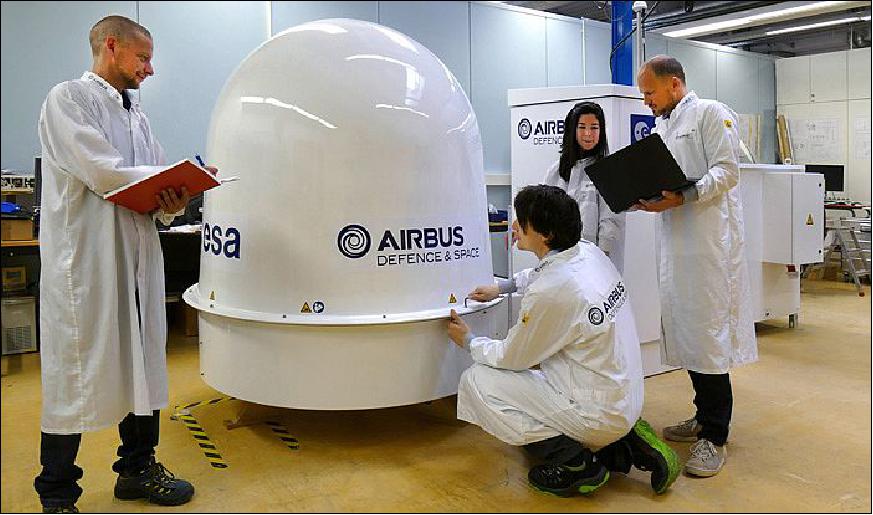
• July 25, 2014: ESA has welcomed the arrival of PHARAO, an important part of ESA's atomic clock experiment that will be installed on a platform outside to ESA's Columbus Laboratory of the ISS (International Space Station) in 2017. 15)
• In the fall of 2011, the ACES mission is in the manufacturing and test phase C/D. All instruments and subsystems are in an advanced state of development with engineering models delivered and flight models manufacturing started. The ACES Payload and Ground Segment Critical Design Reviews (CDR) have been successfully passed. The ACES Engineering Model (EM) workbench has been integrated and thoroughly tested at the CNES facilities in Toulouse. 16)
The manufacturing and assembly of the flight model is now proceeding towards a launch with HTV to the International Space Station in the timeframe 2015-2016. ACES is designed for a mission duration of 1.5 years with the possibility for extension to a minimum of 3 years (Ref. 16).
The payload prime contractor, Airbus DS (former EADS Astrium), leads an industrial consortium for the design, development and delivery of the flight payload and the ground segment.
• In 2010, the ACES mission is in phase C/D. All instruments and subsystems are in an advanced state of development with engineering models delivered or in final assembly. The ACES Engineering Model (EM) workbench has been integrated and thoroughly tested at the CNES facilities in Toulouse. 17) 18) 19)
Under the agreement, CNES will fund and develop the PHARAO atomic clock and deliver it to ESA for integration into ACES. CNES will also support the performance tests and deliver the ground console to be used to operate PHARAO from CADMOS (Centre d'Aide au Développement de la Microgravite et aux Operations Spatiales) in France. - ESA will develop ACES and the accommodation hardware needed for PHARAO and will integrate its operations into the overall European ISS and Columbus operations. ESA will also develop the SHM clock, which is funded by the European Program for Life and Physical Sciences (ELIPS). SHM was initially a Swiss project.
• On Dec. 15, 2009, ESA and CNES signed an agreement that paves the way for the launch of a high-accuracy atomic clock to be attached to the outside of the European Columbus laboratory onboard the ISS. The ACES Payload Critical Design Review (CDR) and the Ground Segment Preliminary Design Review (PDR) have been successfully passed in 2009.
Launch
A launch of the ACES/PHARAO platform on a SpaceX Dragon vehicle is expected in 2020 and installed on the ISS CEPF (Columbus External Payload Facility), using the ISS robotic arm (Figure 5, Ref. 11).
Orbit
Near-circular orbit of the ISS, mean altitude of ~400 km, inclination of 51.6º, period of ~ 90 minutes.
The planned mission duration is 1.5 to 3 years. During the first six weeks, the functionality of the clocks and of MWL will be tested. Then, a period of 6 months will be devoted to the characterization and performance evaluation of the clocks. During this phase, a clock signal with frequency inaccuracy in the 10-15 range will be available to ground users. Under microgravity conditions, it will be possible to tune the linewidth of the atomic resonance of PHARAO by two orders of magnitude, down to sub-Hz values (from 11 Hz to 110 mHz). After the clocks optimization, performances in the 10-16 range both for frequency instability and inaccuracy are expected. In the second part of the mission (12 months, possibly extended up to 30 months), the on-board clocks will be compared to a number of atomic clocks on ground.
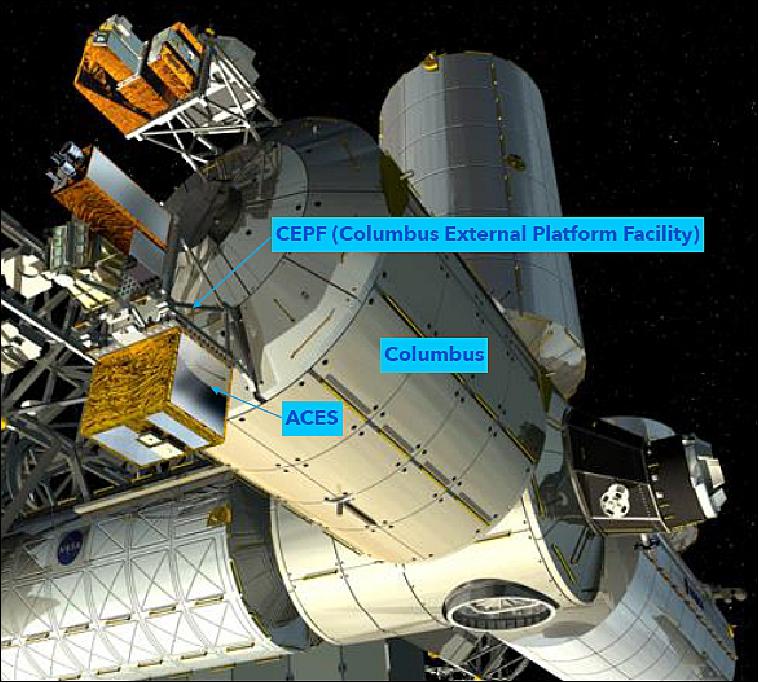
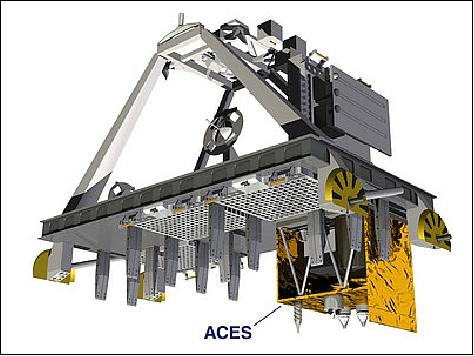
ACES (Atomic Clock Ensemble in Space) Experiment
The ACES performances will be used to conduct a suit of fundamental physics experiments to test Einstein's theory of general relativity with improved accuracy. With the progress recently achieved by clocks in the optical domain, accuracy levels even higher than originally foreseen will be reached.
According to Einstein's theory, identical clocks placed at different positions in stationary gravitational fields experience a frequency shift that, in the frame of the PPN (Parameterized Post-Newtonian) approximation, depends directly on the Newtonian potential at the clock position. The comparison between the ACES onboard clocks and ground-based atomic clocks will measure the frequency variation due to the gravitational red-shift with a 35-fold improvement on previous experiments, testing Einstein's prediction at the 2 ppm uncertainty level (Ref. 5).
The operation of the laser-cooled cesium atomic clock PHARAO opens opportunities in various fields of fundamental research and application fields. The ultra precise measurement of time will also allow relativistic measurements and tests, applications in atmospheric physics and geodesy, navigation and advanced telecommunications.
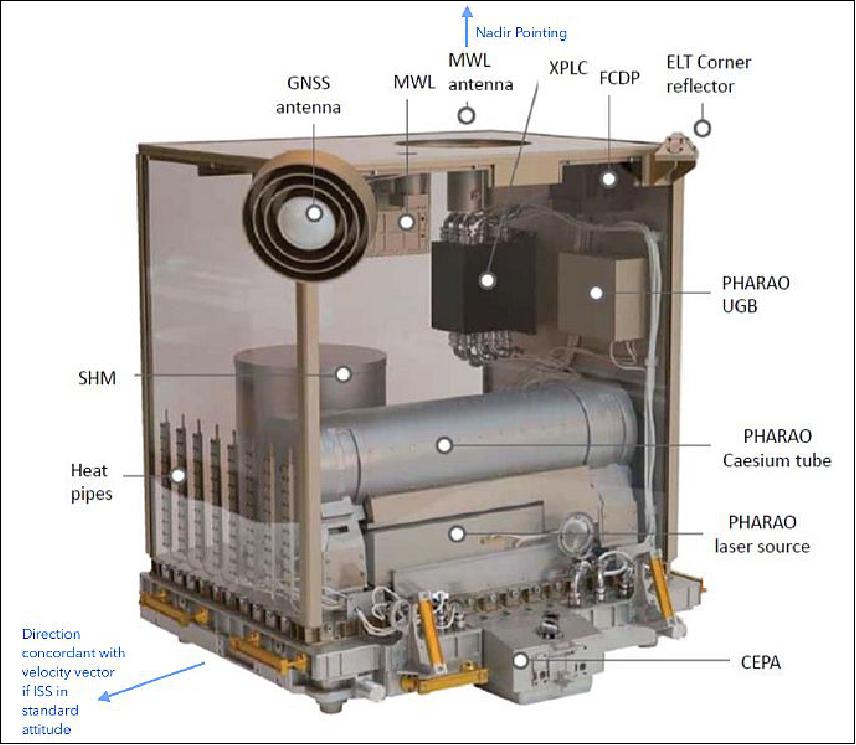
Legend to Figure 7: Front: PHARAO, GNSS antenna; Back: SHM, side panels removed for better visibility.
ACES mission objectives | ACES performances | Scientific background and recent results |
Fundamental Physics tests | ||
Measurement of the gravitational red shift | Absolute measurement of the gravitational red-shift at an uncertainty level < 50 ·10-6 after 300 s and < 2 ·10-6 after 10 days of integration time | Space-to-ground clock comparison at the 10-16 level, will yield a factor 35 improvement on previous measurements (GPA experiment). |
Search for time drifts of fundamental constants | Time variations of the fine structure constant α at a precision level of α-1 dα/ dt < 1 x 10-17 year-1 down to 3 x 10-18 year-1 in case of a mission duration of 3 years | Optical clocks progress will allow clock-to-clock comparisons below the 10-17 level. Crossed comparisons of clocks based on different atomic elements will impose strong constraints on the time drifts of α, me/ΛQCD, and mu/ΛQCD |
Search for violations of special relativity | Search for anisotropies of the speed of light at the level δc / c < 10-10 | ACES results will improve present limits on the RMS parameter α based on fast ions spectroscopy and GPS satellites by one and two orders of magnitudes, respectively. |
ACES is a distributed system designed to disseminate a highly stable and accurate clock signal. It consists of a space payload generating the ACES atomic frequency reference and a network of ground terminals connected to high-performance atomic clocks on ground.
The ACES Eexperiment Consists of 2 Instruments (Atomic Clocks- PHARAO and SHM) Plus Two Complimentary Service Tasks 20) 21) 22) 23) 24) 25) 26) 27) 28)
1) PHARAO (Project d'Horloge Atomique à Refroidissement d'Atomes en Orbite): a laser-cooled cesium atomic clock that is exploiting the microgravity conditions onboard ISS to reach unprecedented precision not achievable on Earth. CNES [design by LNE-SYRTE (Observatoire de Paris), LKB (Laboratoire Kastler Brossel) of CRNS (Centre National de la Recherche Scientifique), Paris, and CNES] is in charge of developing and integrating the PHARAO clock, which is the main French contribution to ACES. 29)
2) SHM (Space Hydrogen Maser): a reference clock of ESA and local oscillator for PHARAO.
3) FCDP (Frequency Comparison and Distribution Package): in support of frequency comparison and processing
4) MWL (MicroWave Link): a link for time-frequency transfer to the ground.
The ACES support subsystems are (Ref. 20):
• XPLC (External Payload Computer)
• PDU (Power Distribution Unit)
• Mechanical, thermal subsystems
• CEPA (Columbus External Payload Adapter)
• ELT (European Laser Timing), an optical link provided by ESA
• GNSS receiver - providing orbit determination as an operational function; in addition provision of support applications in the areas of:
- GNSS time and frequency transfer
- Radio-occultation experiments
- Coherent reflectometry experiments.
The ACES payload has a total mass of 227 kg, a volume of 1340 mm x 1117 mm x 1320 mm, and a power consumption of 450 W. ACES will take advantage of the ISS infrastructure (Columbus and ISS) to have TM/TC link capability and power. During the mission no interaction with the ISS crew and all the ECLSS (Environmental Control and Life Support System) subsystems is expected.
PHARAO -a Laser-Cooled Cesium Atomic Clock
PHARAO, which has been developed by CNES in collaboration with the laboratories SYRTE and LKB in Paris, France, is the first primary frequency standard specially designed for operation in space. PHARAO is the main instrument of the ESA mission ACES (Atomic Clock Ensemble in Space). The ACES payload will be installed on-board the ISS (International Space Station) to perform fundamental physics experiments. All the subsystems of the FM (Flight Model) have now passed the qualification process and the whole FM of the cold cesium clock, PHARAO, is being assembled and will undergo extensive tests. The expected performances in space are frequency accuracy less than 3 x 10-16 (with a final goal at 10-16) and frequency stability of 10-13 τ-1/2. 30)

PHARAO extends the well known concept of laser cooling that is used for ground based atomic fountains in a way that allows operability in microgravity conditions. Laser cooling is a technique that uses light to cool atoms to a very low temperature in the µK region.
In the PHARAO clock, the cesium atoms are manipulated in a high vacuum chamber called cesium tube (Figure 9). The laser source provides the laser beams to the cesium tube in order to prepare, select and detect the atoms. The microwave source provides two 9.2 GHz signals to the cesium tube and the corrected metrological 100 MHz signal to the ACES payload. A computer drives the clock operation, receives telecommands from the ground segment and transfers operational telemetry. 31)
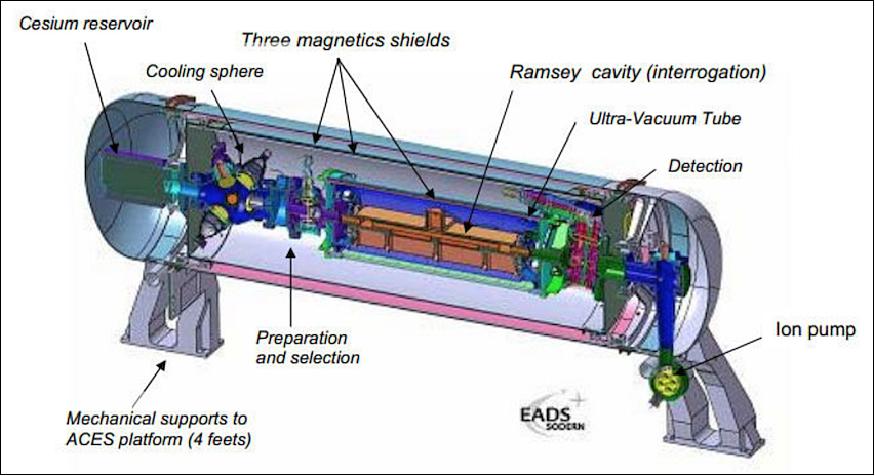
These four subsystems have been space qualified and the flight model of the PHARAO clock is now assembled and tested.
Laser Source
The laser source is an optical bench which provides the various laser beams necessary for the capture, launch, cooling down, atomic selection and detection of the atoms. The laser source is a complex system made of free space optics which must be aligned to handle the laser beams while keeping a high level of stability. The main challenges also arise from the mechanical compatibility with space launch: high level of compactness, low electric power consumption, a wide range of environment temperatures and under vacuum operation.
General requirements: The laser source has three main functions during the PHARAO clock operation: the cold atom preparation, the atomic state selection and the atomic state detection. The different interaction areas inside the cesium tube between the atoms and the lasers beams are depicted in the Figure 9.
Two main laser frequencies are needed to manipulate the cesium atoms. The first one, called the "Master frequency", is tuned around the cesium cycling transition. The second one, called the"Pump frequency", is locked on the transition. The cold atoms are manipulated by six laser beams made of two independently controllable triplets called the "Lower beams" and the "Upper beams".
Cold atom preparation: The cold atom preparation requires the power and frequencies of the lasers to be changed in a specific sequence as described in Figure 10. First the laser beams capture and cool cesium atoms coming from a thermal vapor to form the so-called optical molasses. The vapor pressure of cesium at the level of the preparation area is of 2 x10-6 Pa. The number of captured atoms is a function of the master laser power and detuning. Thus, in order to fulfill the mission requirements, it is considered that a power of 12 mW per beam must be available while the frequency can be red-detuned up to 10 MHz below the cycling transition. The capture time can be changed from 200 ms to several seconds in order to optimize the clock operation. During the cold atom preparation, 5 mW of pump laser power are required to cool the atoms efficiently.
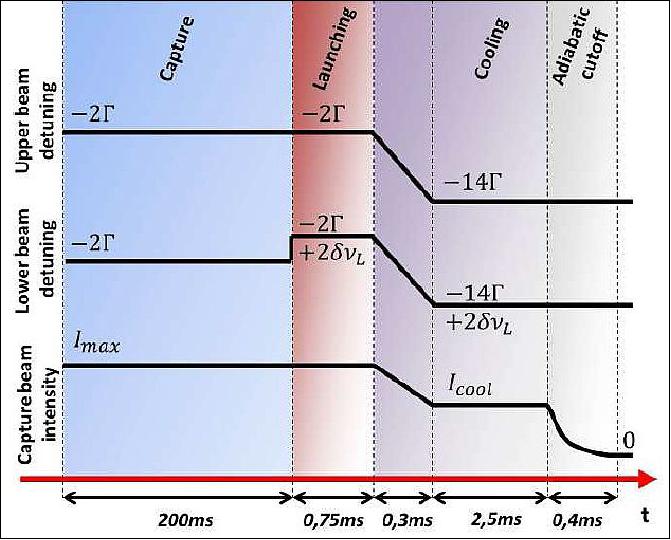
Cold atom selection: The selection uses two laser beams. The first one pumps part of the cloud from F=3 to F= 4. The second one removes all the atoms remaining in F=4 by radiation pressure. This combination allows to slice the cloud (particularly useful at low launch velocity) and to keep atoms in a pure quantum state.
Two optical fibers, carrying respectively the Master frequency and the Pump frequency lasers provide the beams for the cold atom selection. The power, the frequency, and the illumination duration of each beam are adjustable. The maximum powers at the output of the master and pump fibers are, respectively, of 1.5 mW and 400 µW.
Cold atom detection: After selection in the "6S1/2, F = 3,mF = 0" state, the atoms undergo a Ramsey interaction inside a microwave cavity which transfers them in the "6S1/2, F = 4,mF =0" state with a probability P. This transition probability is measured to derive the error signal and frequency corrections to be applied to the microwave source. The detection process consists in measuring the probability P, defined by the ratio N4/(N3+N4) where N3 (resp.N4) is the number of atoms in the "6S1/2, F = 3" (resp. "6S1/2, F = 4") state. After the Ramsey interrogation, the atoms pass through a first master probe beam. The fluorescence light emitted by the cycling transition is collected on a photodiode. These detected atoms are then eliminated by a master pusher beam similar to the one used in the selection process. The remaining cloud, containing only atoms in the F=3 state, is optically pumped to the F=4 state while passing through a pumping beam. These atoms are finally detected by fluorescence with another master beam.
The Master and the Pump lasers are provided to the cesium tube through two optical fibers. In order to perform the detection process, the maximum powers available at the output of the master and pump fibers are 10 mW and 94 µW, respectively.
The relative frequency and intensity fluctuations of the lasers can induce variations on the spontaneous emission rate during the detection process and add noise to the clock error signal. To reduce this noise source, the laser frequency and the laser intensity are locked on a reference.
Laser Source Design
The laser source architecture1 is shown in Figure 11. The frequency of the Master extended cavity diode laser (ECDL-M) at 852 nm is stabilized to the saturated absorption crossover resonance of cesium "6S1/2, F = 4" →"6P3/2, F' = 4/5" through an acousto-optic modulator (AOM-R). To perform the frequency lock, the diode laser current is modulated at 500 kHz with a modulation index of 4. The absorption signal is demodulated to provide the error signal which is integrated and applied to the diode laser current and to the PZT transducer that controls the cavity length. By changing the in-loop AOM-R RF driving frequency the laser frequency can be tuned over 60 MHz with a rate of about 200 MHz/ms. This ECDL/AOM combination provides the frequency reference for all the atom manipulation processes: capture, cooling, selection, and detection.
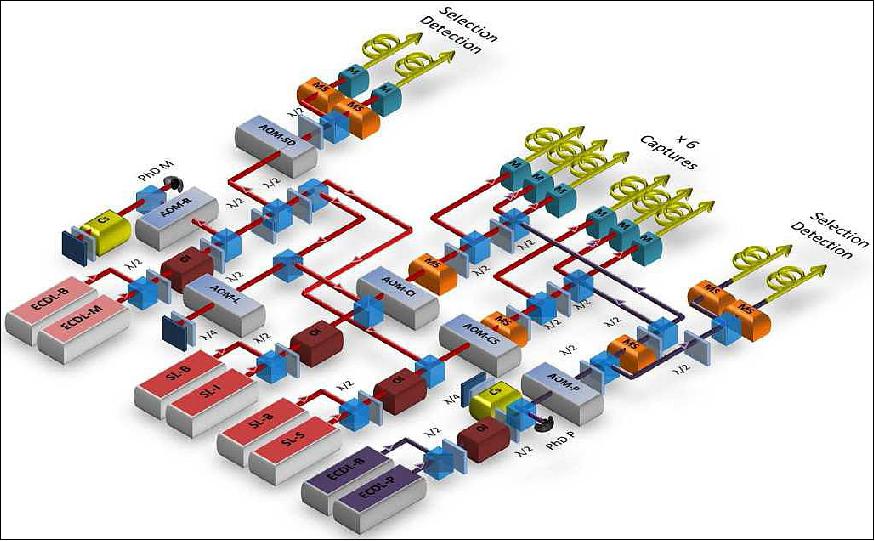
Legend to Figure 11: ECDL (Extended Cavity Laser Diodes) at 852 nm, SL (Slave Lasers), OI (Optical Isolators), AOM (Acousto-Optic Modulator), MS (Mechanical Shutters), M (piezoelectric Mirrors), Cs (Cesium cells). The optical fibers are represented by the yellow arrows. The mechanisms used for switching from the nominal to the backup lasers (ECDL-B, SL-B) are not represented.
The ECDL-M beam is optically isolated by 37 dB and divided into three beams. One beam is coupled into two optical fibers through a 75 MHz acousto-optic modulator (AOM-SD) to adjust the power for the atomic selection (1.5 mW) and detection (10 mW). The detection laser power is measured inside the cesium tube and stabilized by acting on the AOM-SD rf driving power within a 20 kHz bandwidth.
The second beam passes through an AOM-L (Acousto-Optic Modulator) twice before injecting a slave diode laser SL-I. The AOM-L frequency can be adjusted from 87 to 90 MHz to launch atoms (from 5 cm/s to 5 m/s). The third beam injects a second slave diode laser SL-S. The slave diode laser output power is of 100 mW for an input current of 140 mA. After optical isolation, slave laser beams are shifted by 90 MHz by two acousto-optic modulators (AOM-CI and AOM-CS) and split into six beams. The three beams coming from the SL-I slave laser are used to generate the lower capture beams while the three beams coming from SL-S are used for the upper ones. The beams are injected into six optical fibers by using a mirror mounted on PZT transducers.
The PZT mirrors allow a fine alignment of the beam on the fiber core and a power balancing in each of the three molasses beam pairs. The laser powers measured at the output of the fibers, inside the cesium tube, are used to feed a servo-loop acting on the AOM-CI and AOM-CS in order to stabilize the capture beam intensities during the different preparation steps.
A second ECDL-P is locked to the cesium crossover resonance "6S1/2, F = 3i" → "6P3/2, F' = ¾". The beam passes through a 101 MHz acousto-optic modulator (AOM-P) and is split into four. Two beams are injected into optical fibers to repump the atoms during selection and detection. The two others are superimposed on four capture beams to repump the atoms during the preparation process.
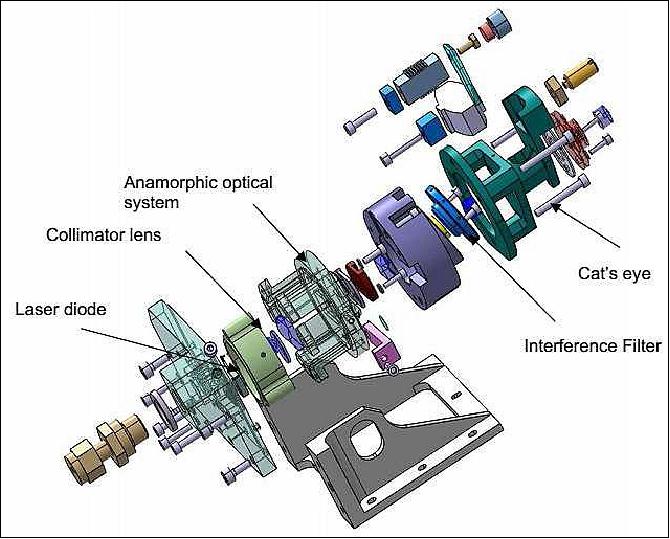
The AOMs allow to switch on/off the beams by 60 dB with a risetime of about 20 µs. In addition, seven mechanical shutters (MS) ensure a complete extinction of the beams (>120 dB). ECDLs and Slave lasers have redundant models (ECDL-B, SL-B). The beams of the redundant lasers are superimposed onto the firsts by means of polarizing cubes. For switching from the nominal to the redundant laser, a λ/2 waveplate is inserted inside the beam before passing through the optical isolator. The setup is composed of 4 nominal lasers (ECDL-M, ECDL-P, SL-I, SL-S) and each laser has a redundant model. The system then offers 24=16 working configurations. The main difficulty arises from the optical alignment process and required mechanical stability to be able to switch among the 16 available configurations while keeping the same laser properties at the end.
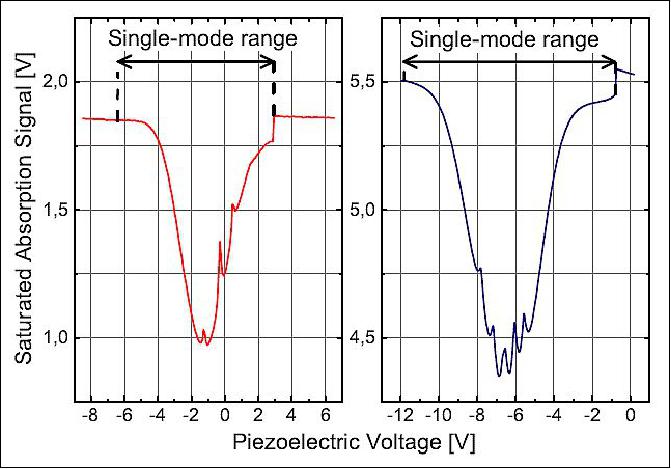
Laser Source Technologies
ECDL (Extended Cavity Laser Diode)
The ECDL consists in an extended cavity laser diode in a linear configuration where the mode selection is performed by an intra-cavity interference filter. This design enables a rugged and reliable behavior and provides a spectral purity 10 to 100 times higher than simple laser diodes. The complete mechanical assembly is depicted in Figure 12. The laser diode is a JDS 5421 in a TO 56 package hermetically sealed with dry air to prevent failure by laser induced contamination. The laser diode is thermally regulated by a Peltier element. At the output of the laser diode, the beam is collimated and shaped by an anamorphic optical system made of cylindrical lenses. The mode selection relies on an interference filter which angle is set to define the wavelength. The external cavity is closed by a cat's eye configuration to ensure the stability of the alignment. The cavity length is of 6.5 cm. The mirror of the cat's eye has a reflectivity of 25% and is mounted on a PZT translator to change the cavity length and tune the laser frequency.
The ECDL achieves a linewidth of 100 kHz and a single-mode tunability of 1 GHz. The Figure 13 shows the saturated absorption spectroscopy of the D2 line of the Cs realized with the ECDL-M and ECDL-P lasers. The frequency locks are achieved with a feedback to the diode current (30 kHz bandwidth) and the length of the external cavity (100 Hz bandwidth). During operation, all the laser parameters and the feedback loop are controlled by the computer. It permanently checks the servo loop and relocks the lasers if necessary.
The nominal output power of the laser is of 30 mW for a current of 100 mA. The laser threshold is reached for a current of 13 mA. The power of the laser spurious side modes have been verified to be below -87 dBc up to 10 GHz from the carrier in a 3 MHz bandwidth.
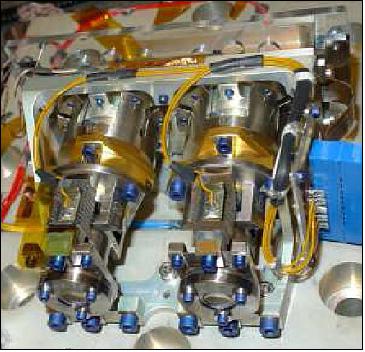
The ECDL module is illustrated in Figure 14. This module includes two identical ECDLs: the nominal laser and its redundancy. The laser modules, and the mechanism for switching from the nominal to the redundant laser, have been qualified for the space environment. In non-operational conditions, they have been submitted to thermal variations (-40ºC / +60ºC ) and random vibrations up to 40 grms. No performance evolutions have been observed after these tests.
In normal operation, the ECDL-M is locked and seeds the two slave laser diodes. Only 50 µW are required to inject the slave lasers. The quality of the injection of the slave laser is checked by monitoring the fluorescence signal of a cesium cell. The high fluorescence level indicates that the slave laser frequency is properly injected by the master laser. The Figure 15 represents the fluorescence signal as a function of the current setpoint of the slave lasers. The slave diode lasers remain injected over a 0.5 mA current variation. In regular operation, the temperature of the slave lasers is automatically set in order to center the fluorescence range on the current setpoint (140 mA). This ensures the stability of the injection process.
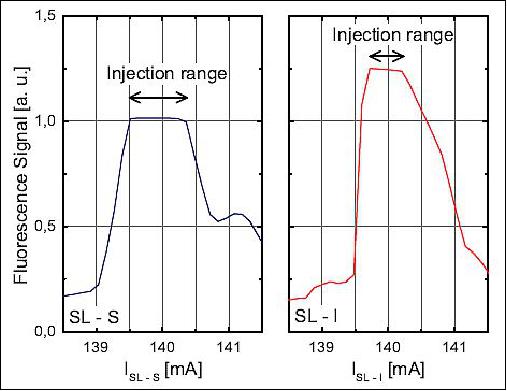
AOMs (Acousto-Optic Modulators)
The AOMs have two main functions in the laser setup. First, they shift and tune the frequency of the laser beams. Second, they control the laser power sent on each set of fibers. The device, shown in Figure 16, has been specially designed by Sodern and A&A optoelectronic to be fully compatible with space applications. In particular, it has been designed to minimize power consumption. Thus the flight model components achieve a diffraction efficiency of 90% for a driving radio-frequency power of 200 mW. Moreover, the crystal shape has been designed to reduce the angle between the diffracted and incident beams to less than 1º, simplifying the design and integration of the laser setup.
The AOM has been qualified for the space environment. In non-operational conditions, the tests have proven a compatibility with thermal variations (±40ºC) and random vibrations up to 40 grms. Nevertheless, a risk of degradation of the AOM transducer has been observed for temperatures exceeding 40ºC.
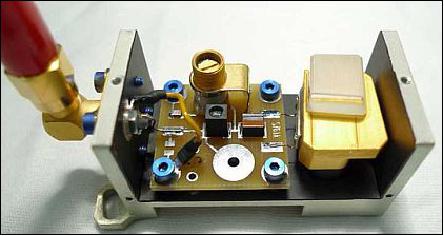
Mechanical Shutters
Mechanical shutters ensure an extinction better than 120 dB in 5 ms on the laser power. This function is essential to prevent any stray light inside the cesium tube during the Ramsey interrogation. The shutter design, depicted in Figure 17 is based on the use of a paddle wheel mounted on a stepper motor.
The extinction ratio measurement was achieved by a fibered photon counter (ID Quantique) calibrated on a low-level radiometer. With this system, the required extinction (120 dB) corresponds to a count rate of 200 Hz. The measurement, which includes the dark count rate, is less than 35 Hz. The device has been qualified to operate up to 2.18 x 108 cycles in the space environment, in agreement with the mission lifetime. In non-operational conditions, the tests have proven a compatibility with thermal variations (-50ºC / +75ºC ) and random vibrations up to 30 grms. This element has no magnetic effects on the clock as the cesium tube is surrounded by 3 layers of µ-metal magnetic shields.
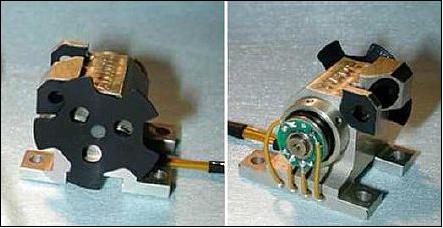
Piezoelectric Mirrors
At the output of the laser setup, the beams are injected in 10 single mode polarization maintaining fibers. For 8 of these fibers, the injection is controlled by a two axis rotating mirror. These tip-tilt mechanisms are used to balance the powers of the 6 different capture laser beams at the percent level. Moreover, they allow the injection of the laser beams into the optical fibers to be periodically re-optimized during the mission if necessary.
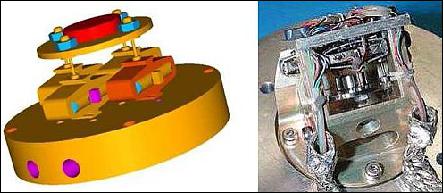
The tip-tilt mechanisms, depicted on Figure 18, have been developed by Cedrat Technologies. They are based on 4 piezoelectric elements to generate two independent tilt movements by push-pull actuation. The action of the piezoelectric elements is servo controlled by 4 strain gages. These mechanisms allow to vary the angle of the mirror over a span of ±2 mrad and achieve a long term angular stability below 4 µrad. The Figure 19 shows the typical evolution of the fiber output power when the angle is scanned in the two axis. In non-operational conditions, the tests have proven a compatibility with thermal variations (-50ºC / +75ºC) and random vibrations up to 30 grms.
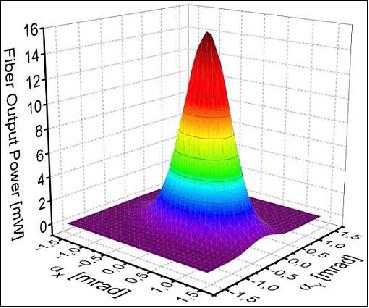
Laser Source Assembly and Qualification
The integrated laser source flight model is represented in Figure 20. The dimensions are of 532 mm x 335 mm x 198 mm. The optical components are mounted on a double-sided optical bench with dimensions of 450 mm x 284 mm x 40 mm. The bench is fixed on the baseplate through four dampers and its first mechanical resonance frequency is above 150 Hz. The temperature of the bench is regulated at 26 ±0.1ºC by means of heaters and Peltier cooler whereas the baseplate temperature can vary from 10 to 33ºC. The laser beams are guided toward the cesium tube by 10 polarization-maintaining fibers (Corning Puremode PM 850 UV/UV-250). The polarization extinction ratio at the output of the fibers is of 30 dB. The power loss induced by the effect of the radiations on the fibers has been estimated to less than 2% over the mission lifetime. Ten FC/PC connectors with insertion loss of 1 dB ensure the link with the cesium tube fibers.
The electronics is located on the laser source mounting plate. It includes the power supplies and drivers of all the active elements: laser diode drivers and servo loop, AOM low phase-noise frequency synthesizers, stepper motor drivers and PZT mirror voltage supply. Moreover, an acquisition system allows to digitize the internal parameters of the laser source. An internal FPGA controls the laser source operation and manages the data communication with PHARAO onboard computer through a serial link. It receives 12 logical signals to trigger the different events during clock sequence. The complete system is powered by a 28 V DC line. The total mass of the laser source is of 22 kg and the average electrical consumption is 30 W.
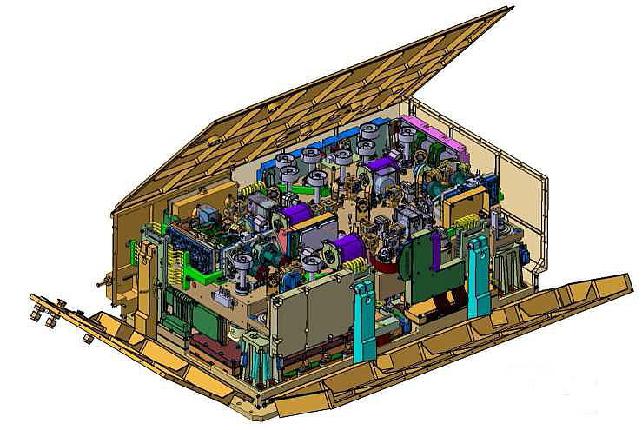
The laser source is one of the most critical parts of a cold atom apparatus. It must keep its performances in terms of delivered optical power, linewidth, frequency stability and spectral agility in a space environment. This system must be reliable enough to undergo high level of vibration and to remain operational over a large range of temperature. The design was validated through the development of a STM (Structural and Thermal Model) and an EM (Engineering Model). The STM was used to perform the qualification tests and the EM was used to validate the functional performances of the laser source.
The complete FM of the laser source, shown in Figure 21, was submitted to a set of acceptance tests. Random vibrations were carried out at a level of 6.5 grms. Thermal variations in non-operational conditions were made between -32 and +40ºC. Optical performances of the flight model, including output power level and laser spectral purity verifications, were performed after each acceptance tests. Finally, the performances of the flight model were tested in operational conditions in the thermal range of +10ºC / +33.5ºC under vacuum, corresponding to the actual environmental conditions onboard the ISS external support of the European Columbus laboratory. Moreover, EMC (Electro-Magnetic Compatibility) tests were carried out on the EM for qualification and on the FM for acceptance. As the mission will take place in low orbit, the instrument will be submitted to a very low radiation dose of about 700 rad over 3 years. However, the compatibility of each component of the laser system with this dose has been verified.

Laser Source Performances
Frequency Noise and RIN Measurements
The frequency noise and the RIN (Relative Intensity Noise) of the ECDL-M have been measured at the output of the detection fiber. The frequency noise has been measured by a beat note method between the ECDL-M and ECDL-P in closed loop. The PSD (Power Spectral Densities) are given in Figure 22. These two features are critical for the performances of the detection system. In this part, an estimation of the impact of the ECDL-M frequency noise and RIN on the PHARAO clock stability is presented.
The calculation of the influence of the laser frequency noise and RIN on the clock stability is presented in Appendix A. We carry out the numerical application of this calculation for 7 launching velocities v0. In each case, the contribution of the frequency noise and RIN on the stability of the clock at 1 s is calculated. The results are summarized in the Table 2. The frequency and intensity noises of the detection lasers have a very small impact on the clock stability, especially for low launching velocities. For high launching velocities, the clock stability is impacted at a non-limiting level compared to the expected quantum projection noise. Thus, the performances of the instrument are not limited by the frequency and intensity noises of detection laser. Moreover, in the calculation, the contribution of laser frequency noise to the clock stability is largely overestimated (Γ/2 detuning). In the real case this contribution is then negligible.
v0 (m/s) | σν @ 1 s | σRIN @ 1 s |
0.15 | 6.7 x 10-15 | 1.1 x 10-16 |
0.20 | 1.1 x 10-14 | 1.8 x 10-16 |
0.30 | 1.7 x 10-14 | 2.6 x 10-16 |
0.60 | 2.6 x 10-14 | 3.7 x 10-16 |
1.00 | 3.3 x 10-14 | 4.4 x 10-16 |
3.00 | 5.7 x 10-14 | 6.3 x 10-16 |
3.54 | 6.4 x 10-14 | 6.7 x 10-16 |

Cold Atom Manipulation
The different PHARAO subsystems have been assembled on the ACES baseplate and connected together. To mimic the in-orbit environment, PHARAO is tested in a vacuum chamber (~ 2 x 10-6 mbar). This significantly changes the thermal behavior of the different subsystems. Coils surround the chamber to compensate for the Earth magnetic field and allow reproducing magnetic orbital variations along the PHARAO main axis.
![Figure 23: Measurement of the laser behavior during the preparation sequence. (a) Master laser detuning. Γ= 5.3 MHz is the natural linewidth of the 133Cs D2 line. (b) Master power evolution of one upper capture beam (PM Up[1]). (c) Relative power difference of the capture beam PM Up[2, 3] and PM Low 1, 2, 3] compared to PM Up[1], image credit: CNES](/api/cms/documents/163813/4608707/ACES-Pharao_Auto15.jpeg)
The first step of the testing phase was to tune all the laser source and cesium tube parameters regarding the capture, the cooling, launching, selection, slicing and detection of the atoms. These sets of parameters have been optimized for on-ground operation in which the atoms are launched upwards at 3.54 m/s. In this specific configuration, the velocity of the atomic cloud decreases along the cesium tube due to the gravity. The atom velocity at the level of the selection and detection system is then respectively of 3.2 and 1.3 m/s. Some of the parameters determined during these tests will need readjustment once in orbit (e.g. launching velocity can be changed at will from 0.05 to 5 m/s) owing to the peculiar behavior of the cold atom cloud in microgravity.
First, the parameters of each phase of the preparation sequence, represented in the Figure 10, have been set up in order to get the largest number of atoms at the the lowest temperature. The Figure 23 presents the master laser detuning and the capture beam powers during a typical preparation sequence. The laser detuning has been measured with a frequency to voltage converter by a beat note technique. The measurement shows that the capture beam powers remain balanced within 5% during the preparation sequence. The temperature and the number of atoms have been optimized using the time-of-flight signal recorded by the detection system. As the number of detected atoms is large and can saturate the detected signal, the loading time is set to 200 ms and the capture laser power is decreased to 5 mW/beam for the on-ground test configuration. The number of atoms is determined from the fluorescence value. The current set of parameters enables to capture up to 5 x 107 atoms at a temperature of about 1 µK.
Second, the power of the pumping and pushing selection beam have been optimized. The power of the pushing beam PMSel has been set to 2.8 mW in order to prepare the cloud in a pure F=3 quantum state. Then, the efficiency of the pumping beam has been verified by measuring the remaining number of detected atoms in F=3 after the selection. For 0.3 mW of pump power,a minimum of atoms (1%) is reached corresponding to the residual atoms in F=3 after the cooling phase. These parameters allow an efficient slicing of the atomic cloud, depicted in the Figure 24.

Finally, the detection system has been tested. The master power PMDet has been set to 3.9 mW in order to guarantee the efficiency of the pushing beam. A pumping power PPDet of 20 µW ensures an optimal operation of the detection system in the test configuration where the atoms velocity is 1.3 m/s at the detection level. The detection pump power can be adjusted up to 94 µW. The power margin is then sufficient for higher launching velocities. In standard operation, due to magnetic level selection and clipping by the microwave cavity apertures, typically 1.4 x 106 atoms are detected. The size of the detected cloud is 16 mm.
Output Power Stability
In order to test the reliability of the PHARAO clock in operational conditions, the FM was submitted to orbital cycling tests. During this period of 65 hours, the payload is submitted to thermal and magnetic oscillations representative of the environmental conditions onboard the ISS. The laser source behavior during the orbital cycling tests is presented on the Figure 25. The Figure 25(a) depicts the evolution of the temperature at the level of the laser source baseplate during the test. The optical powers are measured inside the cesium tube (i.e. at the output of the optical fibers).

Legend to Figure 25: (a) red: Temperature at the level of the laser source baseplate. black: Magnetic field in the launching direction measured inside the cesium tube. (b) Stability of the master detection power (PMDet, red), of the selection master power (PMSel, black) and of the pump detection power (PPDet, blue). (c) Stability of the upper (PMUp[1, 2, 3]) and lower (PMLow[1, 2, 3]) master power during the capture phase. The data are averaged over 100 s. (d) Stability of the captured (NCapt) and detected (NDet, blue) atom number. The captured atom number data are presented shot-to-shot (black) and averaged over 100 s (red).
The capture master laser power is given on the Figure 25(c) for the upper (PMUp[1, 2, 3]) and lower (PMLow[1, 2, 3]) beam triplets. First, we see that the relative power stability of the 6 beams remains within 1%. This is due to the small power instability correlated to the temperature. The measurements exhibit a long term drift of the laser power (0.3%/day). This small drift was caused by an anomaly in the recalibration software of the piezoelectric mirrors which has been corrected after the test. The result of the test is compliant with the power stability specification of ±3%. The four capture pump laser powers, which are not critical for the number of captured atoms, have also been measured and remain constant over the entire test, without apparent drifts. The number of captured and detected atoms, given on Figure 25(d), are perfectly correlated to the drift of the capture laser power. These variations will be canceled by the correction of the software anomaly.
The laser powers in the selection and detection systems are represented on the Figure 25(b). The power in the selection master laser (PMSel), which is not optically servo controlled, is stable at the level of 3%. A correlation analysis shows that this power has a thermal sensibility of 1%/ºC. This behavior is then compliant with the power stability specification of ±3%. The power in the detection master laser (PMDet), which is optically servo controlled, shows a stability below the measurement sensitivity (<0.5%). The power in the detection pump laser (PPDet), which is free running, shows a 15% stability over the 65 hours considered. The measurement exhibits a small sensitivity to the temperature variations at the level of 3%/ºC. It is slightly larger than the initial specification (±5%) but the stability of this power is less critical than expected for the detection process since no significant influence on the detected atom number has been observed. Nevertheless, a periodic adjustment of PPDet has been added after the tests in order to prevent any long-term drift.
Concept
The core of the ACES project is the laser-cooled cesium atomic clock, PHARAO, that is exploiting the microgravity conditions onboard the ISS to reach unprecedented precision not achievable on Earth. In fact, a cold atomic clock works more accurately under weightlessness than under Earth's gravity. This is related to the principle termed "atomic fountain" which is used in the clock. Under microgravity conditions, the cold atoms traverse a resonant cavity, with a slower speed than on Earth. In the cavity, the cold atom interact two times with a microwave field tuned on the transition between the two hyperfine levels of the cesium ground state (Ref. 5).
The interrogation method, based on two spatially separated oscillating fields (Ramsey scheme), allows the detection of an atomic line whose width is inversely proportional to the transit time between the two interaction regions. In a microgravity environment, the velocity of the atoms along the ballistic trajectories is constant and can be continuously changed over almost two orders of magnitude (5-500 cm/s) allowing the detection of atomic signals with sub-Hertz linewidth.
The clock signal is obtained from the combination of two atomic clocks: a cold cesium clock PHARAO as a primary frequency standard and an active hydrogen maser as a freewheel oscillator. The comparison with Earth-based clocks is performed by two way time transfer links operating in the microwave domain,MWL (Microwave Link)) and in the optical domain , ELT (European Laser Timing). Ground terminals will mainly be located in time and frequency laboratories, while the mission will be operated from the ACES USOC (User Support and Operation Center), installed at CADMOS (Centre d'Aide au Développement de la Microgravite et aux Operations Spatiales) in France.
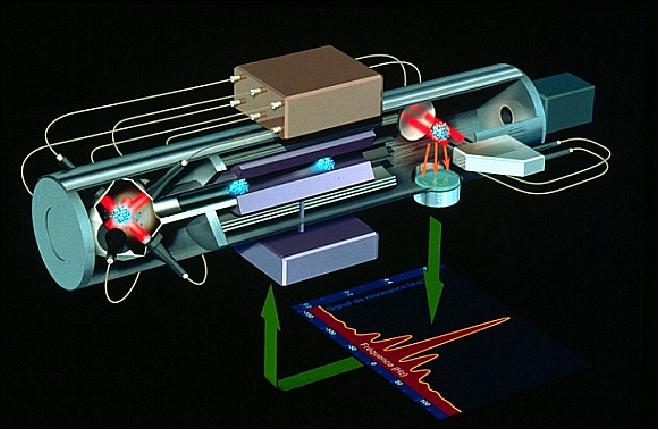
The PHARAO Instrument is Composed of the Following Subsystems 32)
TC (Cesium Tube): In which atoms are captured, launched, cooled, selected and detected after undergoing a microwave interaction within a microwave cavity. The cesium tube provides ultra-vacuum conditions throughout the atomic path and applies a constant and extremely uniform magnetic field along the atomic path, especially inside the microwave interrogation chamber. It includes also the ion pump high voltage supply (CV-THT), which is mounted separately on the ACES baseplate. 33)
SL (Laser Source): SL is an optical bench which provides the various laser beams necessary for the capture, launch, cooling down, atomic selection and detection of the atoms.
SH (Microwave Source): SH supplies the signal to drive interrogation and preparation cavities.
UGB (On Board Management Unit): UGB processes the detection signal to command the frequency corrections to be applied to the microwave source in autonomous mode or transmitted to ACES-XPLC in the other operational modes. It also synchronizes the different phases of the atomic cycle, manages the measurements acquisitions and the remote control systems in order to modify the functional parameters of the instrument.
BEBA (Electronic Unit): BEBA controls the cesium tube magnetic coils and acquires analog signals issued by the cesium tube.
Unit | Mass (kg) | Size (L x W x H, mm) | Power consumption (W) |
TC | 44 | 990 x 336 x 444 | 5 |
SL | 20 | 529 x 330 x 178 | 40 |
SH | 7 | 300 x 270 x 117 | 25 |
UGB | 6 | 245 x 240 x 120 | 26 |
BEBA | 1 | 134 x 118 x 85 | - |
Total (including harness, fixations and margin) | 91 | 1000 | 114 |
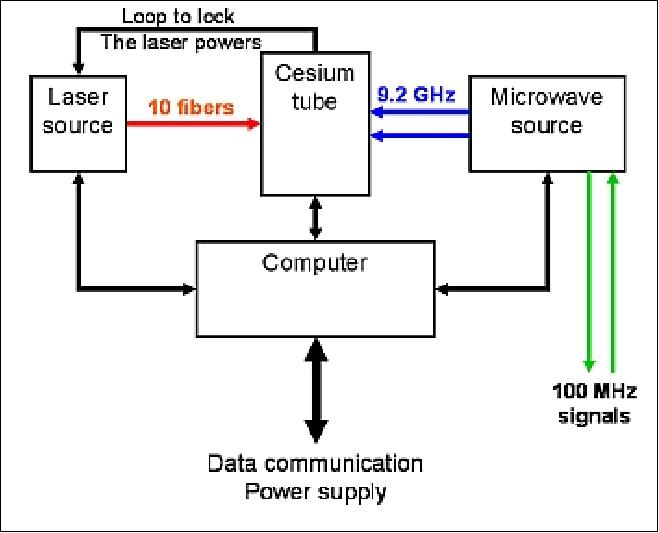
SHM (Space Hydrogen Maser)
The second time and frequency source O/B of ACES is SHM, an active hydrogen (H) maser for space applications. The clock operates on the hyperfine transition of atomic hydrogen at 1.420405751 GHz. H2 molecules are dissociated in a plasma discharge and the resulting beam of H atoms is state selected and sent in a storage bulb. The bulb is surrounded by a sapphire-loaded microwave cavity which, tuned on the atomic resonance, induces the maser action.
The SHM device is developed at Spectratime, Switzerland, under ESA contract. SHM provides ACES with a stable fly-wheel oscillator. The main challenge of SHM is the low mass and low volume requirement when compared to ground H-masers. SHM has a mass budget of 42 kg and a volume of 390 mm x 390 mm x 590 mm. A dedicated ACT (Automatic Cavity Tuning) system has been developed to maintain the microwave cavity tuned to resonance. The ACT system continuously injects two tones symmetrically placed around the H-maser signal. The two tones are coherently detected and the unbalance between their power levels is used to close a feedback loop acting on a varisator which steers the response frequency of the microwave cavity and stabilizes it against thermal drifts.
The SHM EM0 (Engineering Model 0) has already been delivered in 2009 with performances and interfaces representative to the flight model (e.g. onboard software). The manufacturing of the SHM EM1 representing the SHM FM (Flight Model) in form, fit and function has commenced.
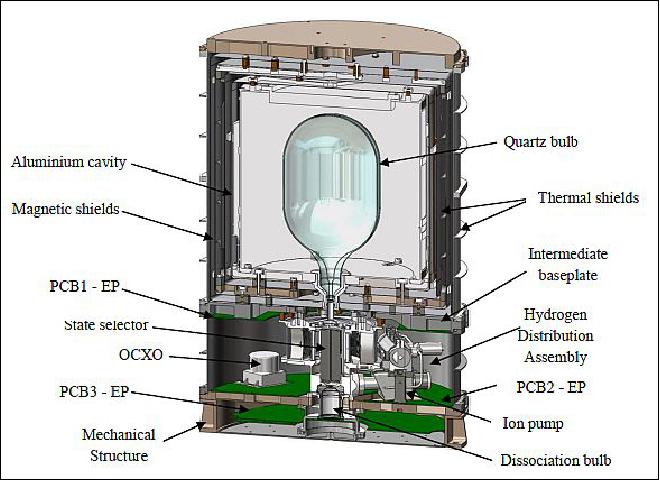

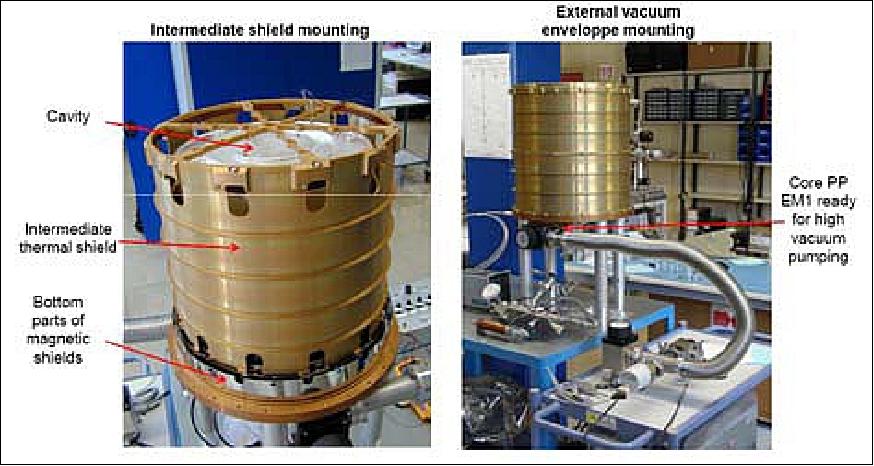
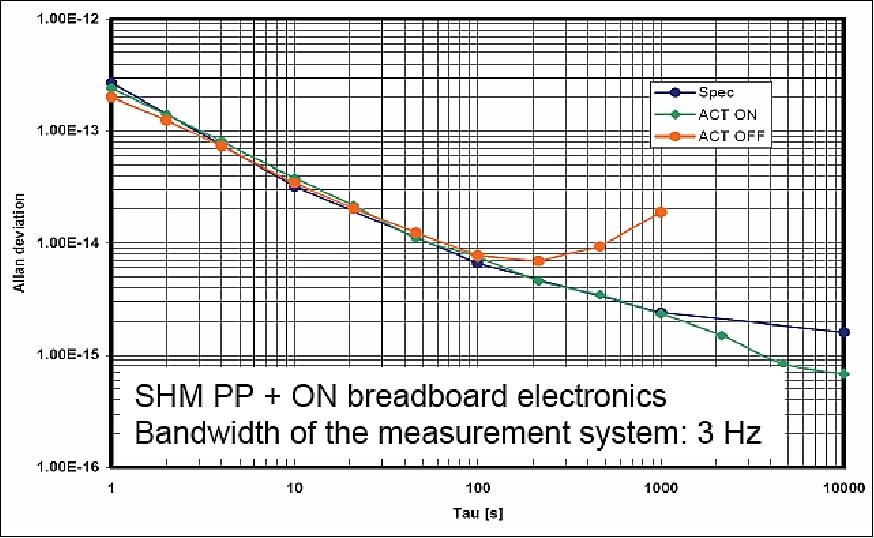
FCDP (Frequency Comparison and Distribution Package)
FCDP is the central node of the ACES payload. Developed by Airbus and Timetech (Stuttgart) under ESA management, FCDP is the on-board hardware which compares the signals delivered by the two space clocks, SHM an PHARAO, measures and optimizes the performances of the ACES frequency reference, and finally distributes it to the microwave link. Practically, FCDP combines SHM and PHARAO measurements in an optimum way providing 100MHz clock signals and comparing them in both frequency and phase and it is the main block of the short-term servo-loop.
The direct comparison of the two clocks has two purposes: (1) to drive the short{term servo{loop for phase locking PHARAO local oscillator onto SHM (Figure 32) and (2) to evaluate the onboard clock stability. FCDP is also in charge of distributing the ACES clock signal to MWL and ELT for comparison with high performance ground clocks.
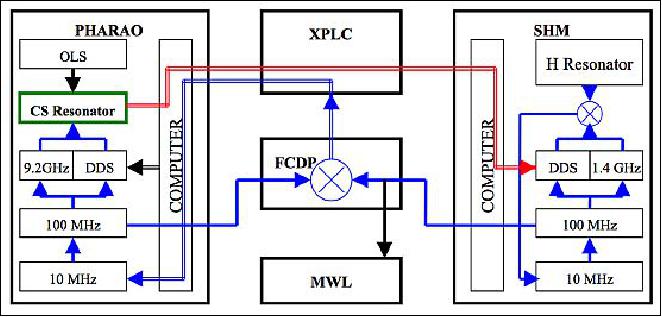
The engineering model of the ACES-FCDP has been completed (Figure 33) and tested in 2009. The noise introduced by FCDP on the distributed clock signal rapidly averages down entering the 10-18 regime already after 104 seconds of integration time. Ultra-low phase noise electronics is extremely important to distribute and characterize the signal of high-performance atomic clocks. This technology is now available in a compact system, ready to be used for space applications.
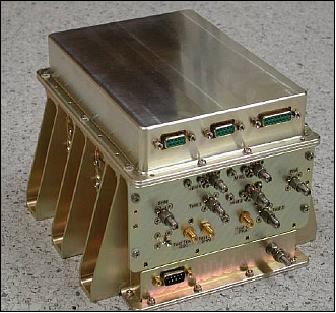
MWL (MicroWave Link)
The ACES clock signal distributed by FCDP is finally transmitted to ground stations by the ACES microwave link. MWL, developed by Airbus DS, Kayser-Threde (Munich) and Timetech under ESA management, is a two-way crosslink microwave signal transfer system for comparing ACES with high performance ground clocks (Ref. 12).
The MWL system consists of the MWL flight segment, integrated into the ACES payload and several MWL GTs installed worldwide at major time and frequency laboratories participating in the ACES experiment collaboration. The system concept of MWL is based on the two-way frequency and time transfer principle that is already used by metrological institutes since many years. The ACES MWL is designed as a coherent, dual frequency, two-way crosslink in Ku-Band. A second downlink exists in S–Band for measurements of the ionospheric refraction. It operates continuously thanks to the carrier frequency in the Ku-band (around 15 GHz) that also allows for a noticeable reduction of the ionospheric delay. A PN code modulation of the carrier removes the phase ambiguity between successive comparison sessions separated by large dead times.
In addition to the two transmitters (S–band and Ku–band), the Flight Segment incorporates also four Ku-band receiver channels, allowing simultaneous contacts with up to four MWL GTs. The different simultaneous ground users are distinguished by a specific PN code and Doppler shift. The four identical receiver channels are called DLL.
Code and carrier phase stability determine the performance levels achievable in the comparisons of distant clocks. The MWL long-term stability is ensured by the continuous calibration of the receiver channels provided by a built-in test-loop translator. For shorter durations (~300 seconds, corresponding to the ISS pass duration), the time stability is driven by the noise performance of the Ku-band transmitter and receiver and the reproducibility of each DLL channel after proper calibration of internal delays.
The 100 Mhz chip rate has already enabled a time stability better than 2 ps to be achieved with code measurements. Carrier phase stability is shown in Figure 35, where time deviations down to 80 fs at about 100 s are reported. For longer durations, time deviation remains well below the 1 ps level even in the worst conditions of signal to noise density ratio (C/N), corresponding to very low elevation angles of the ISS over a ground terminal. The thermal sensitivity of the system has been measured and used to calibrate MWL phase comparison data against temperature variations. The sensitivity to a series of key parameters such as clock input power, received signal C/N, supply voltage, Doppler, Doppler rate, etc. has been measured. The susceptibility of the system to narrowband and broadband interference, as well as to multipath effects has been characterized.
• Two-way link (Ref. 20):
- Removal of the troposphere time delay (8.3-103 ns)
- Removal of 1st order Doppler effect
- Removal of instrumental delays and common mode effects.
• Additional down-link in the S-band:
- Determination of the ionosphere TEC (Total Electron Content)
- Correction of the ionosphere time delay (0.3-40 ns in S-band, 6-810 ps in Ku-band)
• Phase PN code modulation: Removal of 2π phase ambiguity
• High chip rate (100 Mchip/s) on the code:
- Higher resolution
- Multipath suppression
• Carrier and code phase measurements (1 per second)
• Data link: 2 kbit/s on the S-band downlink to obtain clock comparison results in real time
• Up to 4 simultaneous space-to-ground clock comparisons.
The MWL engineering model of the flight segment electronic unit (Figure 34) has been completed and tested.

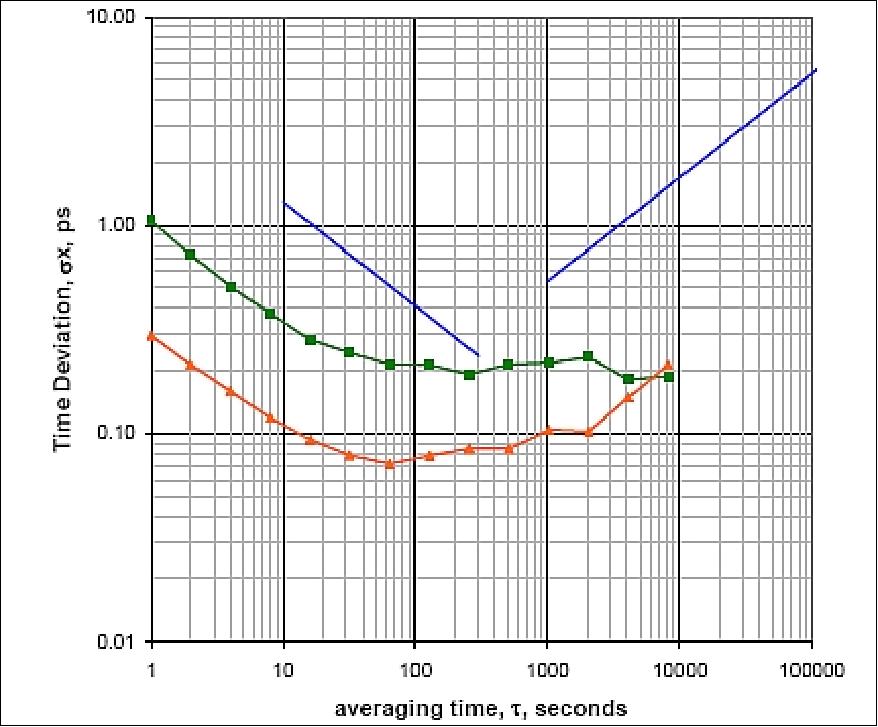
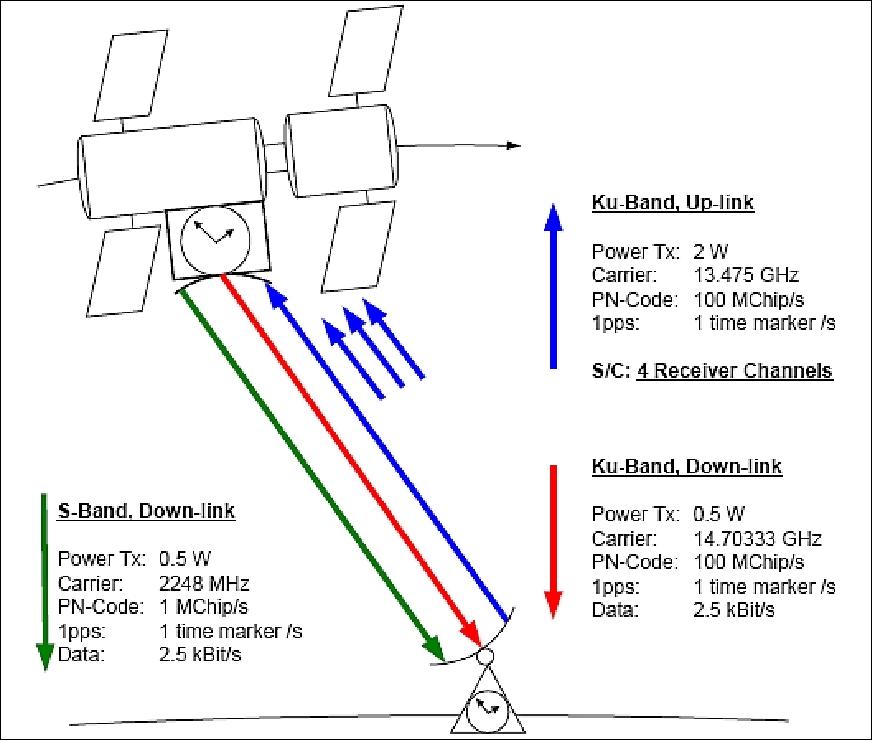
The engineering model of the flight segment S-band and Ku-band antennas (Figure 37) have been completed and tested. The antennas exhibit a extremely flat phase pattern over the complete field of view covering 140º.


ELT (European Laser Timing)
ELT is an optical link that will be part of the ACES mission; ELT is developed by the Czech Space Research Center. The on-board hardware of ELT consists of a CCR (Corner Cube Reflector), a SPAD (Single-Photon Avalanche Diode), and an event timer board connected to the ACES time scale. Light pulses fired towards ACES by a laser ranging ground station will be detected by the SPAD diode and time tagged in the ACES time scale. At the same time, the CCR will re-direct the laser pulse towards the ground station providing precise ranging information.
The laser link will perform comparison of distant clocks, both space-to-ground and ground-to-ground, to frequency uncertainty levels well below 1 x 10-16 after a few days of integration time. Because of the high stability of the ACES clock signal, non-common view comparisons of clocks across intercontinental distances will be possible with ELT. The optical link also finds interesting applications in the distribution of the ACES time reference and in the synchronization of geodetic observatories. Combined with MWL performance, ELT will contribute to the characterization and cross-comparison of two different time transfer and ranging systems. Optical versus dual-frequency microwave measurements also provide useful data for the study of atmospheric propagation delays and for the construction of mapping functions at three different wavelengths.
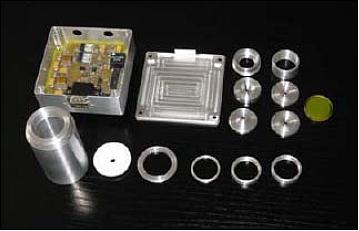
Tests on breadboard level were conducted at the Geodetic Observatory Wettzell (WLRS) and at the University of Graz to assess the feasibility of reaching the specified performances. By ranging satellites equipped with laser reflectors and providing a second independent detection port and laser-pulse timing unit with independent time scale, it has been possible to evaluate the performance of the hardware proposed for ACES.
GNSS Receiver
A GALILEO/GLONASS/GPS receiver will be part of the ACES payload and directly connected to the ACES clock signal. The GNSS system is developed by EREMS, JAVAD and the Geoforschungszentrum Potsdam. The system is designed to provide orbit determination and payload positioning for evaluating relativistic corrections in the space-to-ground clock comparison measurements. Additionally, it offers the potential for remote sensing applications from space in the field of radio-occultation and reflectometry exploring the use of the new GNSS signals.
The GNSS receiver will be accommodated on the ACES payload, with the GNSS antenna looking along the velocity vector of the ISS, with a tilt angle of about 35º in the zenith direction. The GNSS receiver/antenna subsystem is designed to provide ACES with a completely autonomous system for orbit determination, at the same time avoiding extravehicular activity for its installation. Even if not optimal in terms of visibility towards the GNSS constellation, the selected accommodation is able to fulfil ACES requirements for orbit determination. In addition, this antenna geometry turns out to be particularly favorable for supplementary GNSS science such as radio-occultation and reflectometry.
The current (2010) ACES GNSS subsystem baseline consists of a redundant set of commercial-of-the-shelf (COTS) JAVAD GNSS Triumph TRE-G3TH receiver boards and a power and data interface board. The interface board protects the GNSS receiver against latch-up effects, handles the receiver data flow and converts the 100 MHz ACES clock signal down to 10 MHz. The 10 MHz clock signal can be optionally used by the receiver as clock reference signal.
Ground Segment
The ACES GS will provide the monitoring and control facilities for the utilization of the ACES system and the services to the different categories of ACES users: 34)
• Investigator Working Group (IWG)
• Scientific users
• Payload and instrument developers, for engineering support during the mission lifetime.
The ACES ground segment will be integrated within the overall ISS ground architecture providing the communication links between ground and space through the Columbus Control Center and the NASA ground segment.
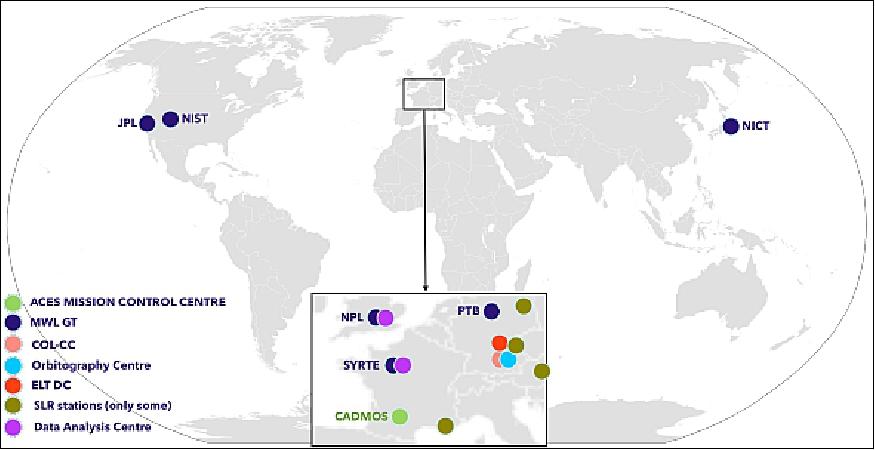
The Main Ground Segment Components are
- ACES-USOC (User Support and Operations Center) providing all functions related to online monitoring and control of the ACES payload and the MWL Ground Terminal network, the ACES operational utilization, the ACES operations planning and the provision of the ACES scientific data to the ACES user community.
- MWL (MicroWave Link) ground terminals distributed worldwide and connected to the ACES-USOC
- Externally distributed facilities for Users, Payload Instrument developers and the POD (Precise Orbit Determination) function.
The ACES ground segment builds on existing infrastructure: ISS and Columbus Laboratory, the SpaceX launch vehicle and Dragon capsule, NASA and Columbus ground segments and CC (Control Centers), and the ACES USOC (User Support and Operations Center) infrastructure collocated at CADMOS (Centre d'Aide au Développement des activités en Micro-pesanteur et des Opérations Spatiales) of CNES in Toulouse, France.
The main functions of the ACES ground segment are the monitoring and control of the ACES payload and of the MWL ground terminals as well as the generation, archiving and distribution of the data products based on the measurements performed in space and on ground.
CADMOS, as the ACES MCC Mission Control Center), is the central component of ACES GS and has overall responsibility of ACES operations. CADMOS receives through Col-CC (Columbus Control Center) ACES downlinked data and issues TCs and uplinks files, also through Col-CC, to ACES FS (Flight Segment).
CADMOS is also the central node for data exchange between the ACES OC (Orbitography Center) and the end users, receives all data from external GS entities such as MWL GTs (MicroWave Link Ground Terminals), ELT DC (ELT Data Center) and high level data products from the DACs (Data Analysis Centers).
IWG (Investigator Working Group)
The IWG, composed of representative of the ACES scientific community, is in charge of coordinating the scientific exploitation of ACES mission data and to request to CADMOS implementation of specific activities during the mission. The interface between IWG and CADMOS is at two levels:
• High level mission interface to define the different science experiments to be carried out during the mission and to organize dedicated ACES symposiums, workshops, etc.
• Operational interface at planning level. IWG provides CADMOS with initial inputs for the ACES mission planning. Based on external constrains, CADMOS iterates the process with IWG in order to establish the consolidated experiment planning which is the input for the daily mission operations planning.
ACES-OC (ACES Orbitography Center)
The ACES-OC is implemented at GSOC (German Space Operations Center), where also the Col-CC (Columbus Control Center) is located. All ACES telemetry is received at Col-CC from NASA (TDRS network) and transferred to CADMOS in realtime via the IGS network. Col-CC also transfer automatically in non real–time TM that has been stored O/B ISS during communications hand-overs. All Columbus payload TM is stored for a certain amount of time at Col-CC and can be replayed on demand of CADMOS in case ACES archive is not complete.
TCs are sent from CADMOS to Col-CC and are then automatically forwarded for uplink on ACES. File transfer is also managed by Col-CC as for all the other European payloads and is coordinated with CADMOS via a dedicated procedure.
ACES-OC computes different orbit data products that are provided to CADMOS regularly and distributed further by CADMOS to the users, namely: ACES FS, MWL GTs, ELT DC. Precise orbit data products are used further by CADMOS and DAC to compute high level data products.- All transfers with CADMOS are automated and continuously performed.
The ACES-OC (Orbitography Center) is responsible for producing three different orbit products of ACES based on the observations of the JAVAD GNSS receiver on a routine basis: 35)
• a combined orbit fit and predicted orbit product, which is delivered in near real-time
• a final high precision orbit product, which is delivered daily with a latency of one or two days
• a mid-term prediction product, which is delivered twice a day in the form of TLEs (Two Line Elements).
Although the POD concept using GPS observations is routinely operated on several LEO missions, with accuracies much better than required for ACES, the POD for the ISS poses new challenges:
- Due to construction reasons the GNSS antenna will be attached to the ACES module with a tilt of 60° from the zenith direction and of 50° in azimuth direction. Hence the field of view is limited and asymmetric w.r.t. the flight direction, which results in a suboptimal geometrical distribution of the observed GPS satellites.
- The solar panels of the ISS further obstruct the field of view of the GNSS antenna limiting the number of observable GPS satellites to five in the worst case.
- The orbit height of the ISS is with ~400 km significantly lower than that of most LEO satellites. Combined with the large surface of the rotating solar panels, this makes modelling of air drag and thus the orbit prediction more difficult than for relatively compact satellites.
Operational Orbit Determination
The ACES-OC will provide three types of orbit products. A combined orbit fit and predicted orbit product, a final orbit product and a medium term orbit prediction product.
The combined orbit fit and prediction product will be generated in near real-time and updated every 90 min and serves two purposes. The first one is to generate accurate position and velocity vectors for the computation of quick-look relativistic clock corrections. The second is to provide a short term prediction for SLR stations and MWL terminals. Hence the product will contain 6 h orbit fit to the observed data, and 6 h prediction.
To generate the near real-time products, the ACES-OC receives all relevant observations from the ACES data stream via the Col-CC. The data will be provided in 5 minute batches and assembled at the ACES-OC to cumulative products in order to reduce the transmission latency. The data package contains raw observations of the GPS, GLONASS and Galileo constellations recorded by the JAVAD GNSS receiver. As a backup for data gaps in the raw observations, the navigation solutions of the JAVAD GNSS receiver and the SIGI (Space Integrated GPS/INS) receiver are provided. The ISS attitude information generated by the SIGI receiver is necessary for orbit determination as well.
The adjusted part of the combined product is computed using the most recent 6 h of raw observation data of the JAVAD receiver with a reduced dynamic orbit determination (RDOD). As a baseline, the IGS (International GNSS Service) ultra-rapid ephemeris product will be used for the near-real time processing. As an alternative, use of DLR's RETICLE (Real-Time Clock Estimation) product or the upcoming IGS real-time products are considered to further increase the quality of near real-time orbit determination.
Subsequently a position fit (PosFit) is performed over the 6 h of precise orbit and propagated for 6 h into the future. The RDOD and PosFit software tools are part of the GHOST package (GPS High precision Orbit determination Software Tools), developed at GSOC. Usually orbit determination products refer to the center of mass (CoM) of the spacecraft. In case of ACES, the orbit trajectory is transformed to the ACES reference point, which is located in the center of the microwave cavity of the PHARAO clock. This facilitates use of the resulting orbit product for the science processing and minimizes the impact of attitude uncertainties in the overall processing chain. The combined orbit fit and prediction product will be delivered in SP3 (Standard Product 3) orbit format and in the CPF (Consolidated laser ranging Prediction Format).
Twice a day, TLEs will be generated based on the results of the latest near real-time POD. These TLEs serve for mid-term planning of MWL and SLR station contacts.
With a latency of a few days, the final orbit product is computed. This period is used to fill potential downlink data gaps and to ensure the availability of high-quality GPS ephemerides. For the final orbit product, rapid GPS ephemerides generated by the CODE (Center for Orbit Determination in Europe) will be used. Similar to the near real-time POD, the final POD is computed with the RDOD software - with the difference, that it is computed over predefined daily 30 h arcs with 3 h overlap to the previous and following days. The overlap periods enable an internal consistency check: if the difference between two overlapping arcs is too large, the automated processing is stopped and an operator has to generate the product manually.
ELT DC (European Laser Timing Data Center) and SLR (Satellite Laser Ranging) Stations
Several ELT SLR stations are involved in the ACES mission to provide additional data to those provided by the MWL GTs. They are existing or enhanced SLRs part of the ILRS (International Laser Ranging Service) network . All the SLR stations are coordinated by the ELT DC, which is the unique interface to CADMOS for SLR stations.
As for the MWL GTs, CADMOS provides regular orbit data, ISS/ACES orbital and attitude data and planning data to the ELT DC, which coordinates the activities of the SLR stations involved in ACES operations.
ELT DC gathers all the data provided by the SLR stations and computes high level science data which are transmitted regularly to CADMOS for archiving. CADMOS does not perform any computation on the data provided by the ELT DC.
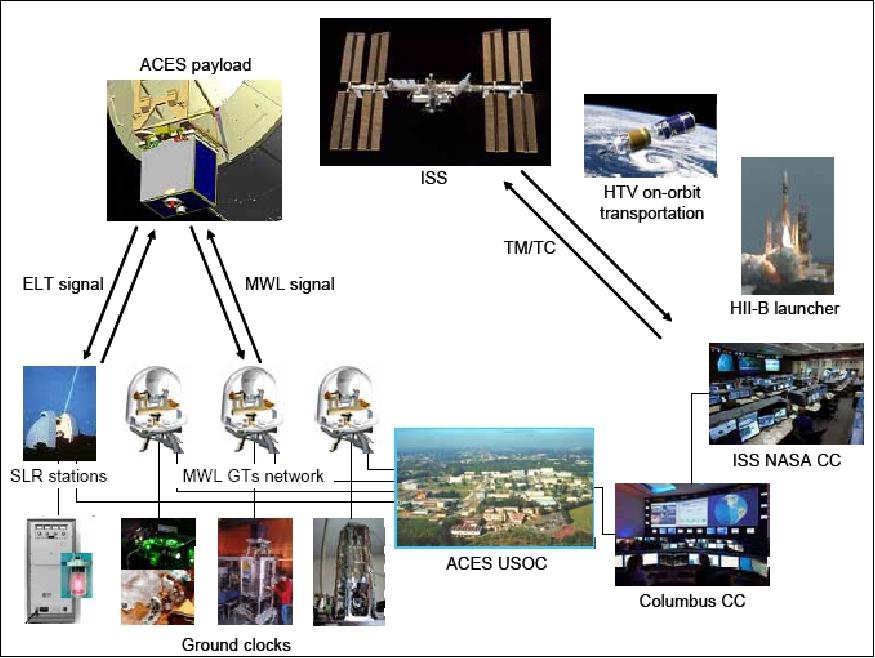
Legend to Figure 41: In the meantime the launch provider has been changed from JAXA HTV transportation to SpaceX Dragon vehicle.
Institutes Hosting MWL GTs (Microwave Link Ground Terminals)
In order to perform the Space-to-Ground link for clock comparisons, several ground sites which host various types of atomic clocks are equipped with MWL GTs. These MWL GTs, distributed all over the world, are linked to CADMOS via Internet. In total 6 fixed MWL GT are foreseen for the ACES mission. They will be deployed at the following institute sites (Figure 40 shows their position).
• PTB (Physikalisch-Technische Bundesanstalt) in Brauschweig, Germany
• SYRTE (Sytèmes de Référence Temps Espace) in Paris, France (SYRTE is a department of the Paris Observatory)
• NIST (National Institute of Standards and Technology) in Boulder, CO, USA
• NASA/JPL (Jet Propulsion Laboratory) in Pasadena, CA, USA
• NICT (National Institute of Information and Communications Technology) in Tokyo, Japan
• NPL (National Physical Laboratory) in Teddington, Middlesex, UK.
In addition, two mobile MWL GTs are foreseen and can be installed at different sites during the mission: (1) the same sites than the fixed MWL GTs, in order to perform calibration measurements, (2) closed to SLRs to be used for cross-calibrations with ELT or (3) alternative sites, for other purposes.
MWL GT (Ground Terminal)
The MWL GT electronics is similar to the MWL flight hardware, symmetry being important in a two-way system to reduce instrumental errors. The ACES MWL GT is a microwave station interfacing the local clock on ground to the ACES payload allowing space-to-ground clock comparisons. To reduce phase instabilities due to the tracking motion, the electronic unit of the MWL GT has been rigidly attached to the antenna unit. The Ku-band signal is delivered to the antenna feeder via a waveguide, a high stability RF cable is used for the S-band. The antenna is a 60 cm offset reflector with a dual-band feed system automatically pointed in azimuth and elevation by a steering mechanism. A computer controls the steering unit based on ISS orbit prediction files, collects telemetry and science data both from the local clock and the MWL GT electronics, and interfaces directly with the ACES USOC (User Support and Operation Center).
The antenna system is housed in a protective radome cupola, which also allows to stabilize the temperature of the enclosed volume by an air conditioning system, part of a separate service pallet. The MWL ground terminal is presently being assembled (Figure 43). After dedicated tests on the ground terminal, a MWL system level test will be conducted. The test will be performed using dedicated test equipment that will allow to reproduce the signal dynamics both in terms of amplitude and frequency (Doppler) variations.
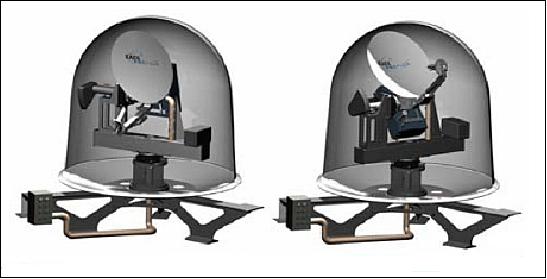
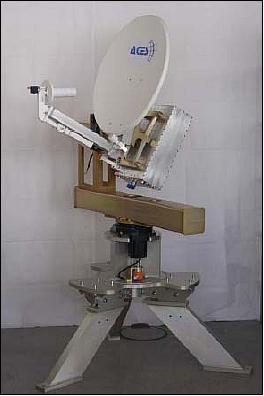
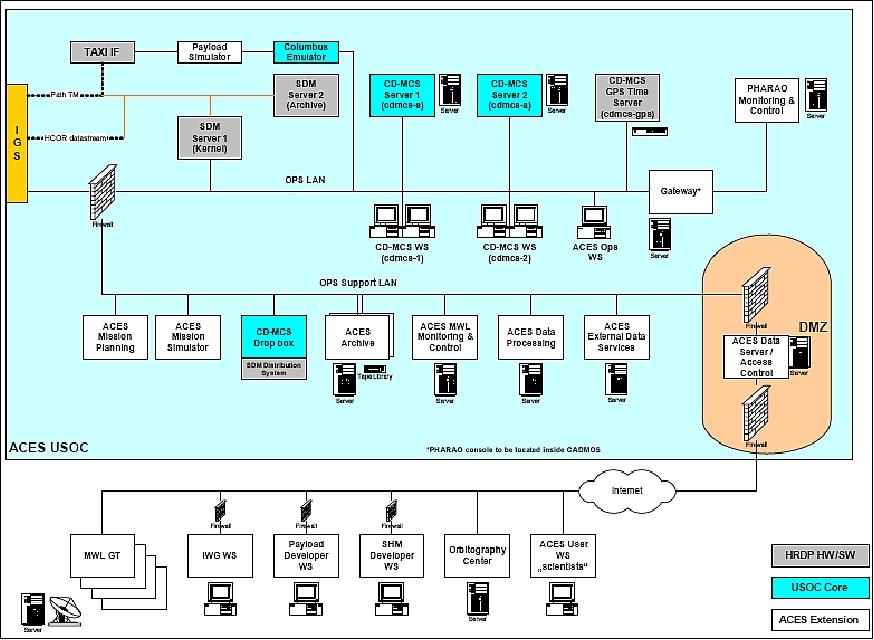
References
1) R. D. Andresen, G. Peters, "European Payloads Selected for Early Utilization on the International Space Station," ESA Bulletin No 98, June 1999, pp. 76-86
2) O. Minster, L. Cacciapuoti, D. Jarvis, N.. Lavery, S. Mazzoni, K.. Norfolk, A. Orr, A. Pacros, S. Vincent-Bonnieu, D. Voss, M. Heppener, "The ESA Program in Physical Sciences in the Framework of the ELIPS-ARISE Program: Research including Applications on the Ground and in Space," Proceedings of the 26th ISTS (International Symposium on Space Technology and Science) , Hamamatsu City, Japan, June 1-8, 2008, paper: 2008-h-12,
3) "Atomic Clock Ensemble in Space (ACES)," URL: http://www.esa.int/SPECIALS/HSF_Research/SEMJSK0YDUF_0.html
4) F. Gonzalez, J. P. Granier, Ph. Laurent, "An advanced technology for a new generation of Cold Atom Space Clock (Pharao)," Acta Astronautica, Volume 47, Issues 2-9, July-November 2000, pp. 335-345
5) R. Much, E. Daganzo, S. Feltham, R. Nasca, L. Cacciapuoti, M. P. Hess, L. Stringhetti, C. Salomon, "Status of the ACES Mission," EFTF-IFCS 2009 (European Frequency and Time Forum - International Frequency Control Symposium), April 20-24, 2009, Besançon, France
6) C. Salomon, "Atomic Quantum Sensors in Space and Fundamental Tests," ISS Symposium 2012 'Research in space for the benefit of humankind,' Berlin, Germany, May 2-4, 2012, URL: http://blogs.esa.int/iss-symposium2012/files/2012/05/ISSMeeting-May2012-v2.pdf
7) http://wsn.spaceflight.esa.int/docs/Factsheets/20%20ACES%20LR.pdf
8) "ACES Platform," CNES, URL: http://smsc.cnes.fr/PHARAO/GP_platform_aces.htm
9) C. Salomon, "ACES: Atomic Clock Ensemble in Space," October 15, 2013, URL: https://artemis.oca.eu/IMG/file/3-Salomon.pdf
10) "Clocks, gravity, and the limits of relativity," ESA, 23 May 2019, URL: http://www.esa.int/Our_Activities/Human_and_Robotic_Exploration/Research
/Clocks_gravity_and_the_limits_of_relativity
11) Marc Peter Hess, Thomas Niedermaier, Klaus Gollinger, Achim Helm, Johannes Kehrer, Marc-Julien Ettori, Achim Kirchmaier, Omar Sy, Rudolf Much, Luigi Cacciapuoti, Claudio Moratto, "ACES - Getting Ready!," Proceedings of the 69th IAC (International Astronautical Congress) Bremen, Germany, 1-5 October 2018, paper: IAC-18.A2.1.4, URL: https://iafastro.directory/iac/proceedings/IAC-18/I
AC-18/A2/1/manuscripts/IAC-18,A2,1,4,x45063.pdf
12) Mauro Augelli, "Atomic Clock Ensemble in Space (ACES) Operations. The ISS External Scientific Payload Looking for Experimental Confirmations on the General Relativity Theory," Proceedings of the 68th IAC (International Astronautical Congress), Adelaide, Australia, 25-29 Sept. 2017, paper: IAC–17–A2,1,3
13) Mauro Augelli, "ACES Operations: an ISS External Scientific Payload Looking for Experimental Confirmations on the General Relativity Theory," Proceedings of the 14th International Conference on Space Operations (SpaceOps 2016), Daejeon, Korea, May 16-20, 2016, paper: 2016 2407, URL: http://arc.aiaa.org/doi/pdf/10.2514/6.2016-2407
14) "Airbus Defence and Space delivers first ACES Ground Terminal," Airbus DS Press Release, Nov. 13, 2015, URL: https://airbusdefenceandspace.com/newsroom/news-and-features
/airbus-defence-and-space-delivers-first-aces-ground-terminal/
15) "Timely arrival of PHARAO Space Clock," ESA, July 25, 2014, URL: http://www.esa.int/Our_Activities/Human_Spaceflight/
Research/Timely_arrival_of_Pharao_space_clock
16) C. Pütz, M. P. Heß, B. Hummelsberger, K. Hausner, R. Nasca, L. Cacciapuoti, R. Much, D. Massonnet, P. Rochat, D. Goujon, W. Schäfer, I. Prochazka, "ACES (Atomic Clock Ensemble in Space) Mission Status and Outlook," Proceedings of IAC 2011 (62nd International Astronautical Congress), Cape Town, South Africa, Oct. 3-7, 2011, IAC-11.A2.1.4
17) Marc Peter Hess, Luigi Cacciapuoti, Andre Clairon, Stephen Feltham, Philippe Laurent, Benoit Leger, Pierre Lemonde, Didier Massonnet, Rudolf Much, Rosario Nasca, Frederic Picard, Pascal Rochat, Christophe Salomon, Wolfgang Schäfer, Roland Stalford, Luca Stringhetti, Oliver Montenbruck, "The ACES mission system development and test status," Proceedings of the 61st IAC (International Astronautical Congress), Prague, Czech Republic, Sept. 27-Oct. 1, 2010, IAC-10.A2.1.9
18) "PHARAO atomic clock agreement signed by ESA and CNES," ESA, Dec. 15, 2009, URL: http://www.esa.int/esaCP/SEMRDI9K73G_index_0.html
19) G. Reibaldi, L. Cacciapuoti, E. Daganzo, S. Feltham, R. Much, R. Nasca, D. Massonet, C. Delaroche, M-P. Hess, R. Stalford, L. Stringhetti, P. Rochat, S. Froidevaux, "ESA Atomic Clock in Space Experiment on the ISS: Getting Ready for Flight," Proceedings of the 60th IAC (International Astronautical Congress), Daejeon, Korea, Oct. 12-16, 2009, IAC-09.A2.1.3
20) L. Cacciapuoti, "ACES: Atomic Clock Ensemble in Space," Proceedings of the GPhyS (Gravitation and Fundamental Physics in Space) Kick-Off Colloquium, Les Houches, France, Oct. 20-22, 2009, URL: http://gphys.obspm.fr/LesHouches2009/GPhyS1009/oct20/ACES_GPhyS_Cacciapuoti.pdf
21) C. Salomon, "ACES: Ultra-stable Clocks in Space Fundamental physics and Applications," NASA Workshop, May 23, 2006, URL: http://www.physics.ucla.edu/quantum_to_cosmos/q2c06/Salomon.pdf
22) Steve Feltham, Francisco Reina, Giacinto Gianfiglio, "ACES - A Time & Frequency Mission for the ISS," 18th European Frequency and Time Forum EFTF 2004., April 5-7, 2004, Guildford, UK
23) "Atomic Clock Ensemble in Space (ACES)," ESA, Oct. 25, 2011, URL: http://www.esa.int/SPECIALS/HSF_Research/SEMJSK0YDUF_0.html
24) Pierre Lemonde, Arnaud Lecallier, Philip Westergaard, Jérôme Lodewyck, Philippe Laurent, Michel Abgrall, André Clairon, Giorgio Santarelli, Peter Wolf, Christophe Salomon, Didier Massonnet, Luigi Cacciapuoti, "Microwave and optical cold atom clocks for space applications," Proceedings of the 7th ICSO (International Conference on Space Optics) 2008, Toulouse, France, Oct. 14-17, 2008
25) L. Cacciapuoti, "Atomic Clock Ensemble in Space, Mission Concept and Status," International Workshop on ACES and Future GNSS-based Earth Observation and Navigation, Munich, Germany, May 26-27, 2008, URL: http://www.iapg.bv.tum.de/mediadb/14961/14962/01_ACES_Status_LC.pdf
26) Wolfgang Schäfer, "Advanced Concepts for Ranging and Time Transfer Applications and Mission Support," GGOS/IGCP 565 Workshop, Graz, Austria, Sept. 30 - Oct. 2, 2009
27) Luigi Cacciapuoti, Christophe Salomon, "ACES - Mission Concept and Scientific Objectives," ESA, March 28, 2007, URL: http://smsc.cnes.fr/PHARAO/ACES_Science_v2_printout.pdf
28) Luigi Cacciapuoti, Christophe Salomon, "Atomic Clock Ensemble in Space," International Symposium on Physical Sciences in Space, IOP Publishing, Journal of Physics: Conference Series, Vol. 327 (2011) 012049, doi:10.1088/1742-6596/327/1/012049, URL: http://iopscience.iop.org/1742-6596/327/1/
012049/pdf/1742-6596_327_1_012049.pdf
29) C. Salomon, "Cold Atom Clocks and Fundamental Tests," TAM (Time and Matter International Conference), Bled, Slovenia, August 27, 2007
30) T. Lévèque, B. Faure, F. X. Esnault, O. Grosjean, C. Delaroche, D. Massonnet, C. Escande, Ph. Gasc, A. Ratsimandresy, S. Béraud, F. Buffe, P. Torresi, Ph. Larivière, V. Bernard, T. Bomer, S. Thomin, C. Salomon, M. Abgrall, D. Rovera, I. Moric, Ph. Laurent, "PHARAO Flight Model: Optical 'On Ground' Performance Tests," Proceedings of the ICSO (International Conference on Space Optics), Tenerife, Canary Islands, Spain, Oct. 7-10, 2014, URL: http://congrexprojects.com/Custom/ICSO/2014/Papers/2.%20Wednesd
ay%208%20October/Session%208B%20Atomic%20Clocks%20-
%20Gravitational%20Wave
%20Detection/2.66014_Leveque.pdf
31) T. Lévèque, B. Faure, F.X. Esnault, C. Delaroche, D. Massonnet, O. Grosjean, F. Buffe, P. Torresi, T. Bomer, A. Pichon, P. Béraud, J. P. Lelay, S. Thomin, Ph. Laurent," Feb. 24, 2015, URL:http://arxiv.org/pdf/1502.06376.pdf
32) http://smsc.cnes.fr/PHARAO/GP_instrument.htm
33) Stéphane Thomin, Olivier Grosjean, Philippe Laurent, "PHARAO's Cesium Tube," Proceedings of the 63rd IAC (International Astronautical Congress), Naples, Italy, Oct. 1-5, 2012, paper: IAC-12-A2.1.4
34) E. Daganzo, S. Feltham, R. Much, R. Nasca, R. Stalford M. P. Hess, L. Stringhetti, "ACES Ground Segment functionality and preliminary operational concept," EFTF-IFCS 2009 (European Frequency and Time Forum - International Frequency Control Symposium), April 20-24, 2009, Besançon, France
35) Martin Wermuth, Oliver Montenbruck, Achim Helm, Luigi Cacciapuoti, "Precise Orbit Determination and prediction of the ISS in the frame of the ACES Mission," Proceedings of NAVITEC 2012, 6th ESA Workshop on Satellite Navigation Technologies, ESA/ESTEC, Noordwijk, The Netherlands,Dec. 5-7, 2012
The information compiled and edited in this article was provided by Herbert J. Kramer from his documentation of: "Observation of the Earth and Its Environment: Survey of Missions and Sensors" (Springer Verlag) as well as many other sources after the publication of the 4th edition in 2002. - Comments and corrections to this article are always welcome for further updates (eoportal@symbios.space).